Right next to the Space Needle in Seattle is Chihuly Garden and Glass. This one-artist gallery showcases Dale Chiluly’s artistry through a series of rooms, eventually leading to an outdoor space with more art and a glass-blowing demonstration.
Chihuly Garden and Glass might be the apex of Chihuly’s commercial pursuits. Meaning, it’s less of an art museum and more of a tourist attraction. That being said, each room is lit and presented so beautifully as to make your jaw drop open at every room entrance. Let’s walk through the whole experience.
Chihuly Garden and Glass
Chihuly Garden and Glass is right behind the Space Needle. If you head down the main avenue from the fountain in front of the Space Needle with the tower on your right, you’ll find the entrance. And the entrance isn’t that remarkable! You probably wouldn’t miss it, but it’s not like there are huge Chihuly sculptures out front. (In fact, there are some glass flowers across the way that might confuse you. These are not Chihuly flowers – don’t get confused!)
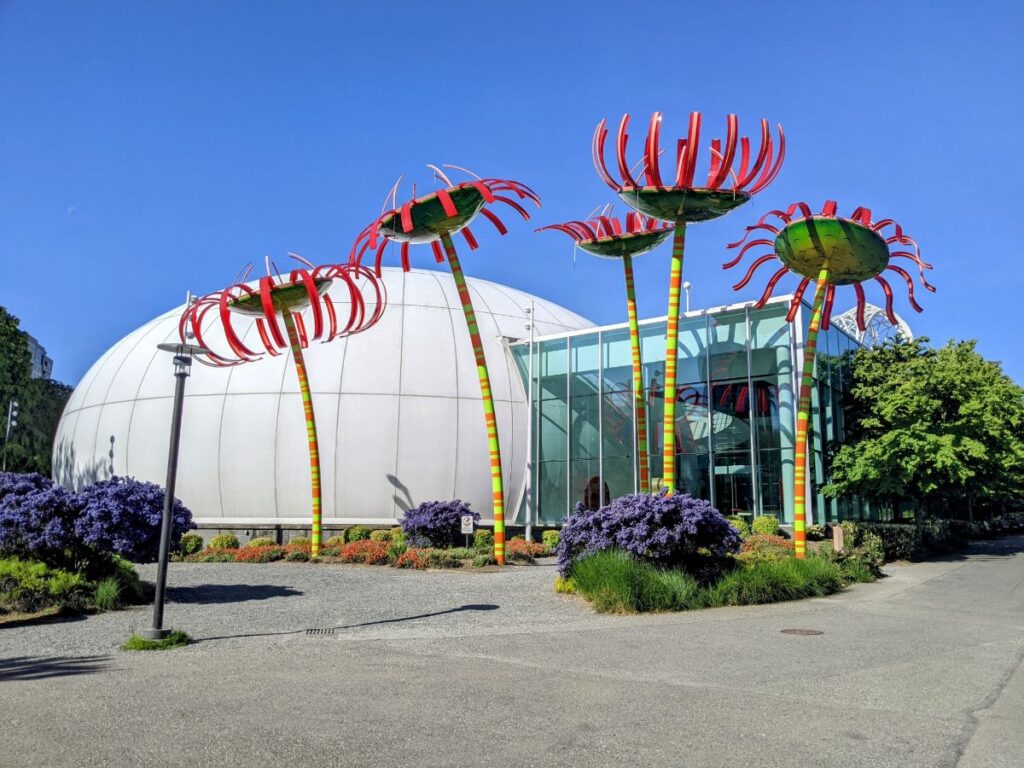
Similarly, the entrance lobby is a little understated. There are ticket counters to the left, a large gift shop to the right, and there are bathrooms past the ticket counters if you need them before you start. Once you get your ticket – or scan one you’ve already bought – you pass into a dark hallway with lighted signs & photos. It almost looks like a section of Living with the Land at Disney’s Epcot.
These signs offer a brief history of the Tacoma-born glass artist Dale Chihuly. He’s known for his craft of blowing and stretching glass to its largest scales and structural limits. A lot of Chihuly’s glass creations are not so unique in and of themselves, but it’s the sheer volume and the scale that is so impressive. The way they are presented, spotlit in these black-box rooms, makes the bright colors really burn your retinas.
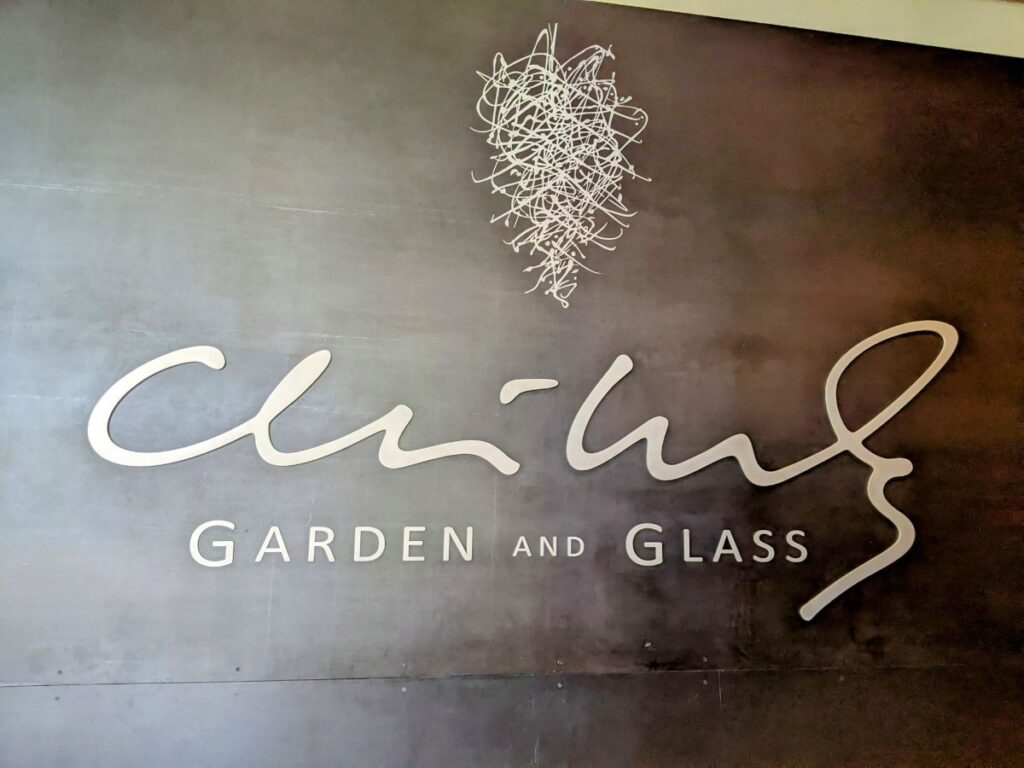
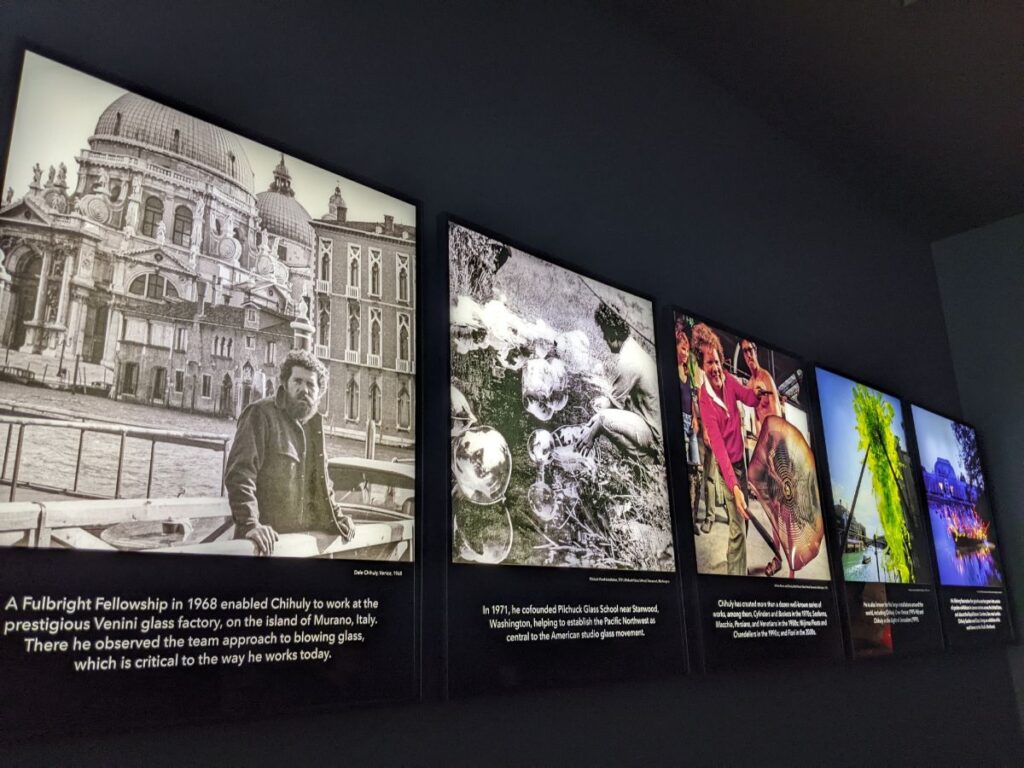
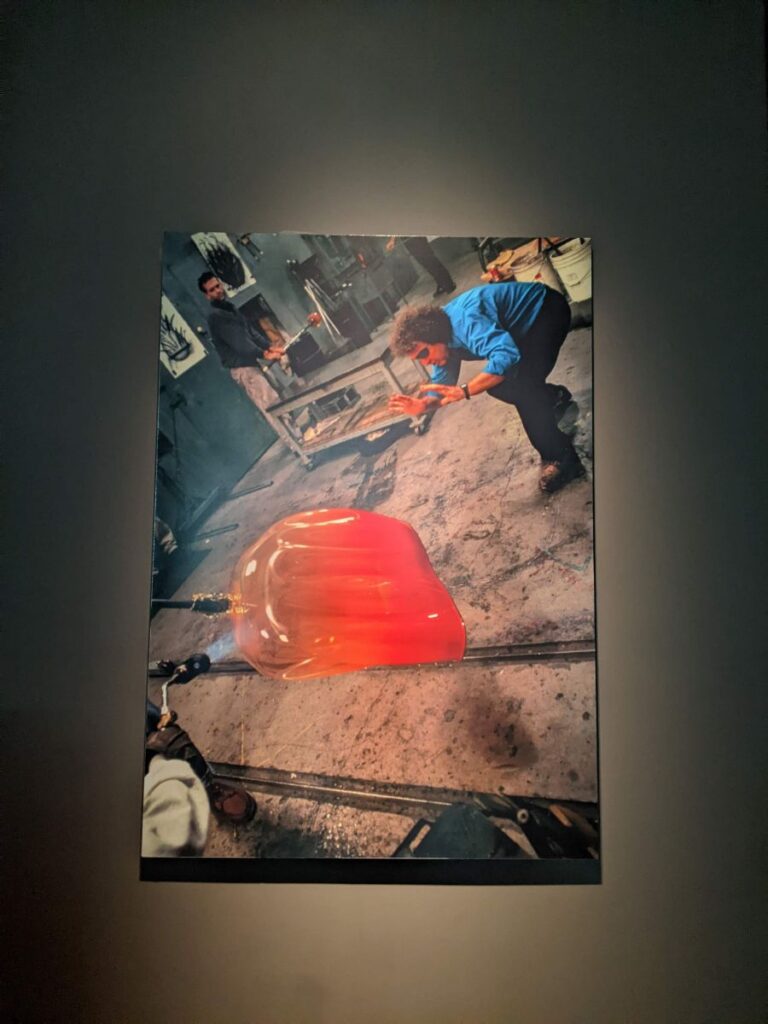
Glass Forest & Northwest Room
Before you get to the super-saturated colors, you start in a room with one large white/clear installation. I believe this was an installation for a winter window in a department store – like Macy’s in New York, but I honestly don’t remember. The official map calls this the Glass Forest, but when I look up Chihuly’s Glass Forest, it’s not this white creation. This looks more in line with his famous chandelier work.
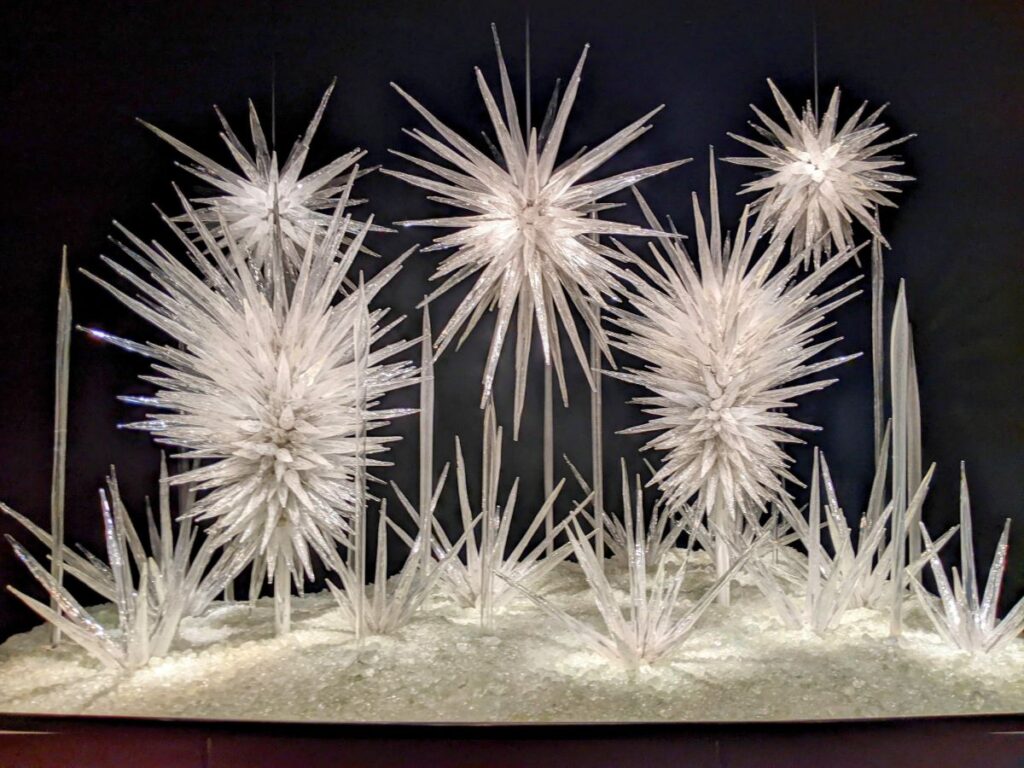
Next up is a room with mellow, natural colors – the Northwest Room. It showcases Chihuly’s pacific northwest influences with natural colors and sepia tones. Shelves along the wall display his cylinders and soft cylinders series, interspersed among his own collection of woven baskets.
At the end of the room is a wall of colorful Native American blankets, while historic photos of Native Americans by Edward S. Curtis hang in two gallery grids. But what I like most about this room are the “baskets” on the long table down the middle. These impossibly translucent bowls nest other impossibly translucent bowls inside in how-did-they-get-it-in-there arrangements. All with soft, striped browns reminiscent of the woven baskets on the walls.
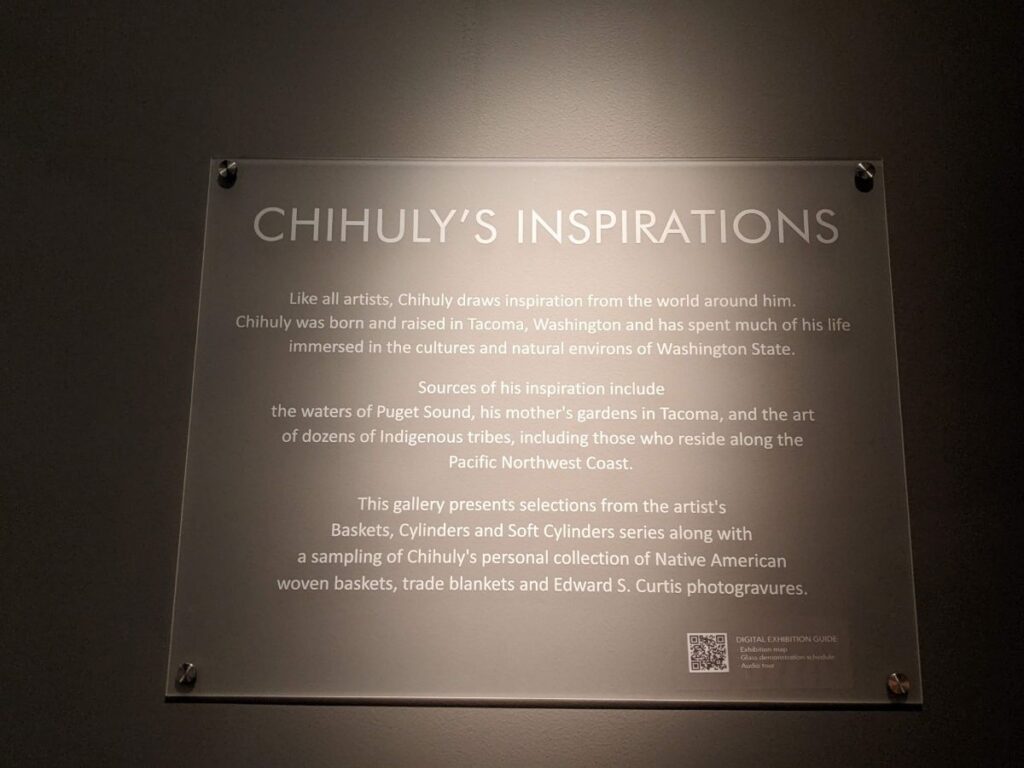
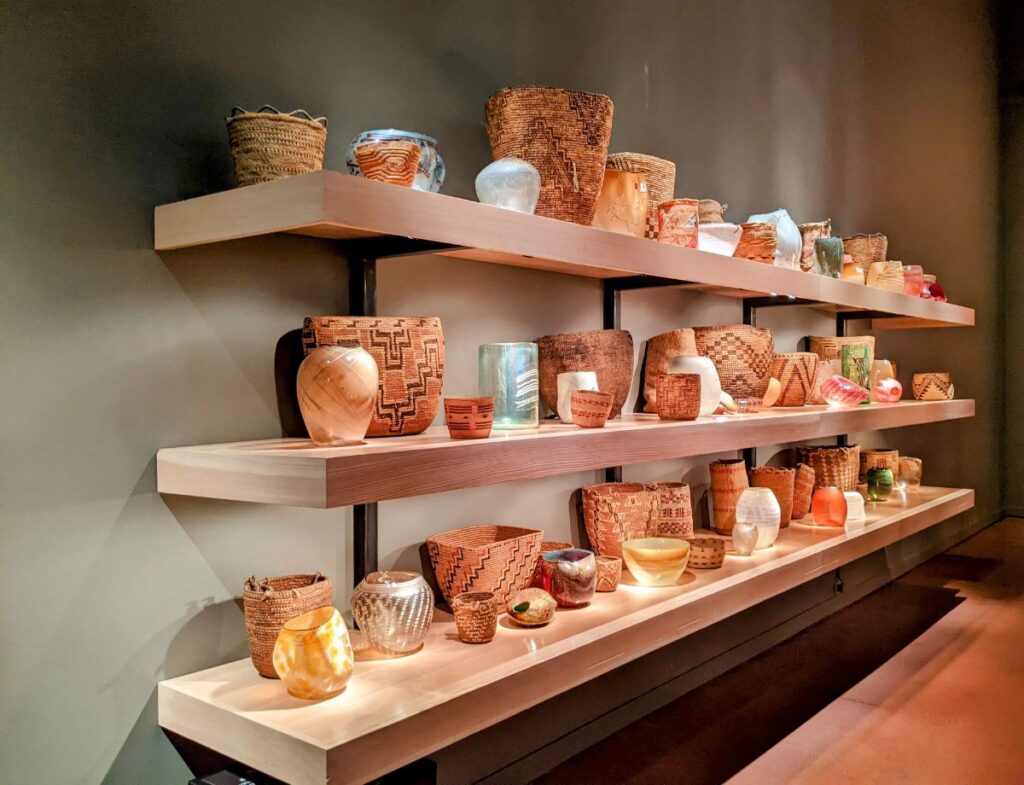
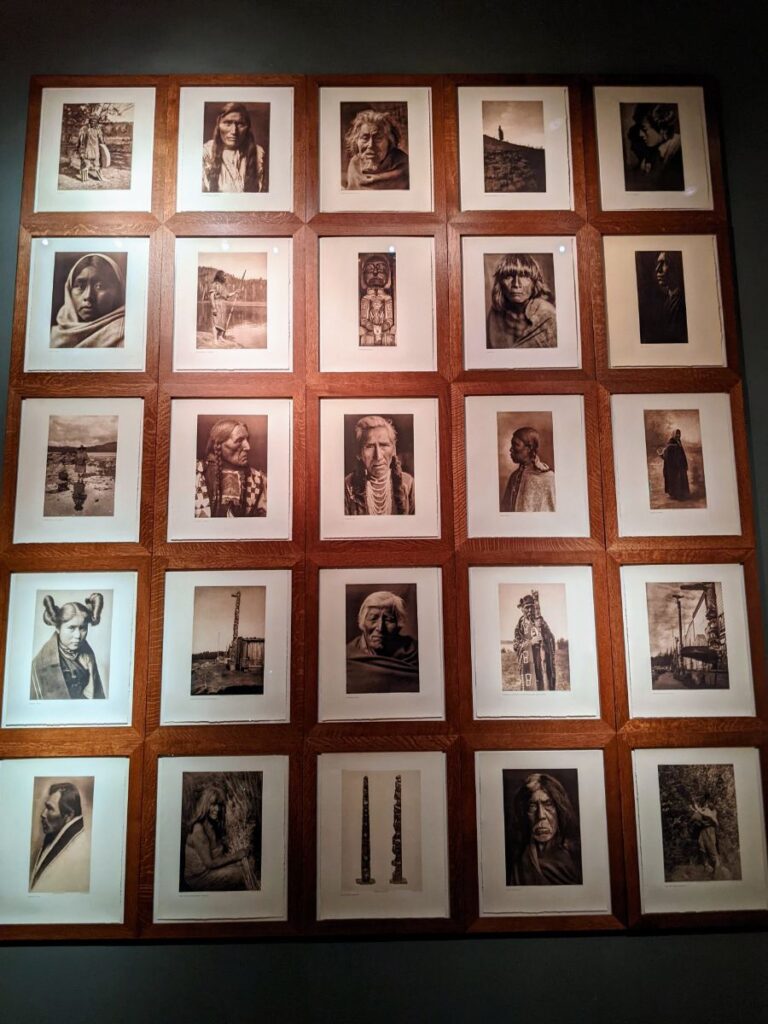
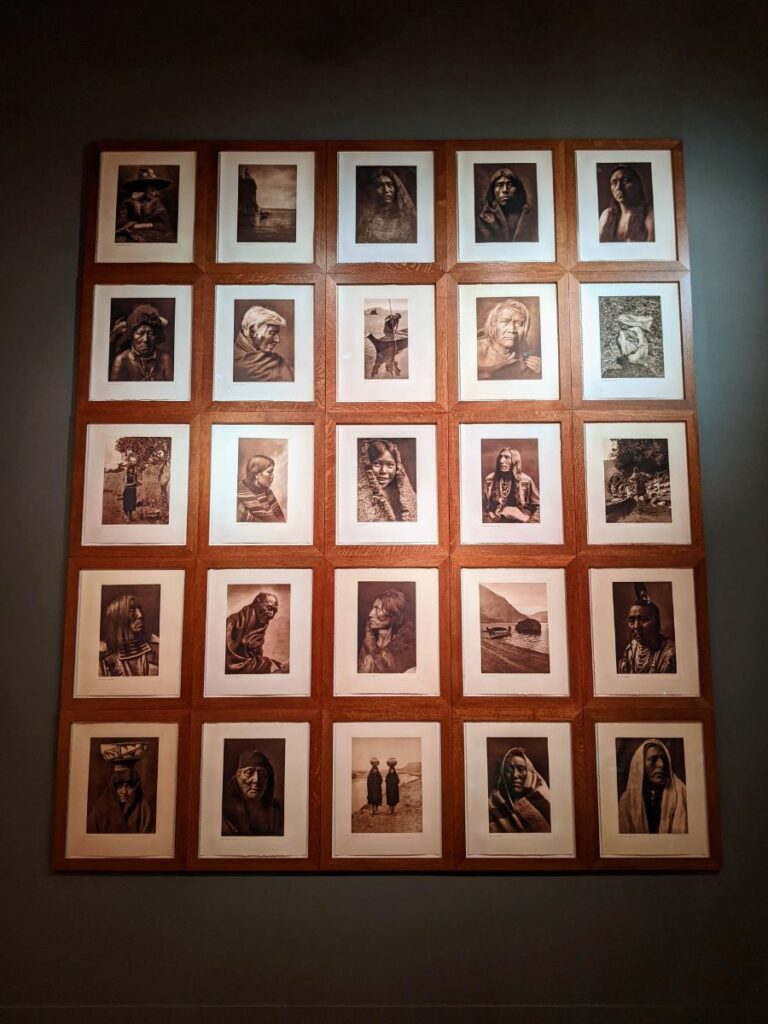
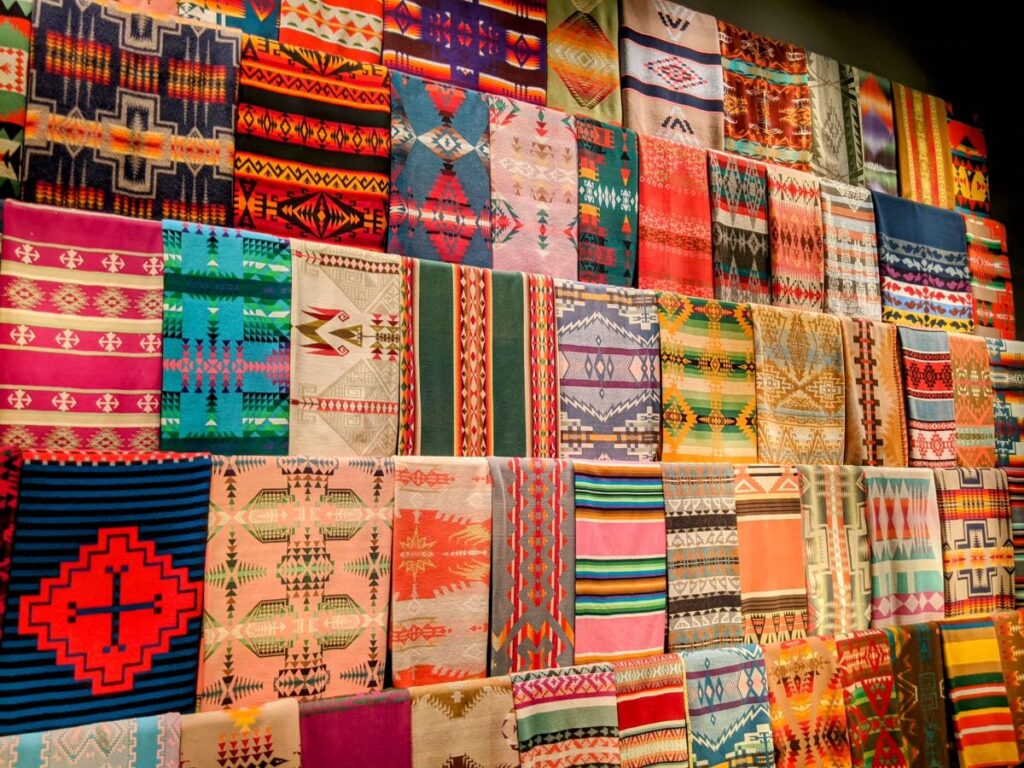
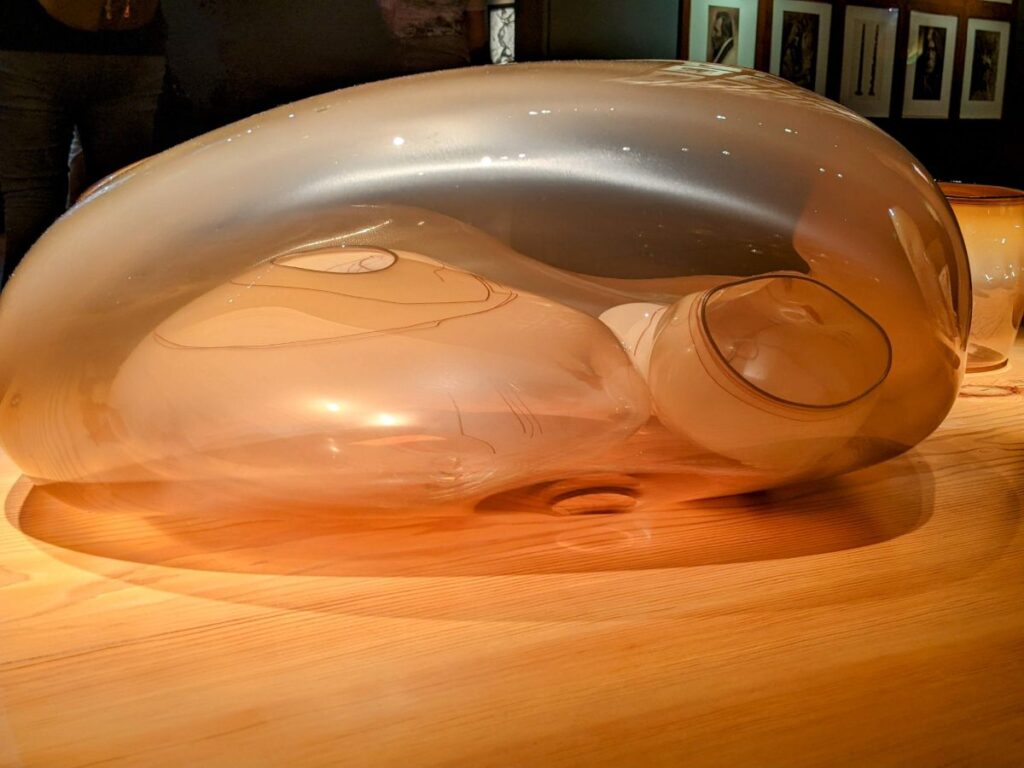
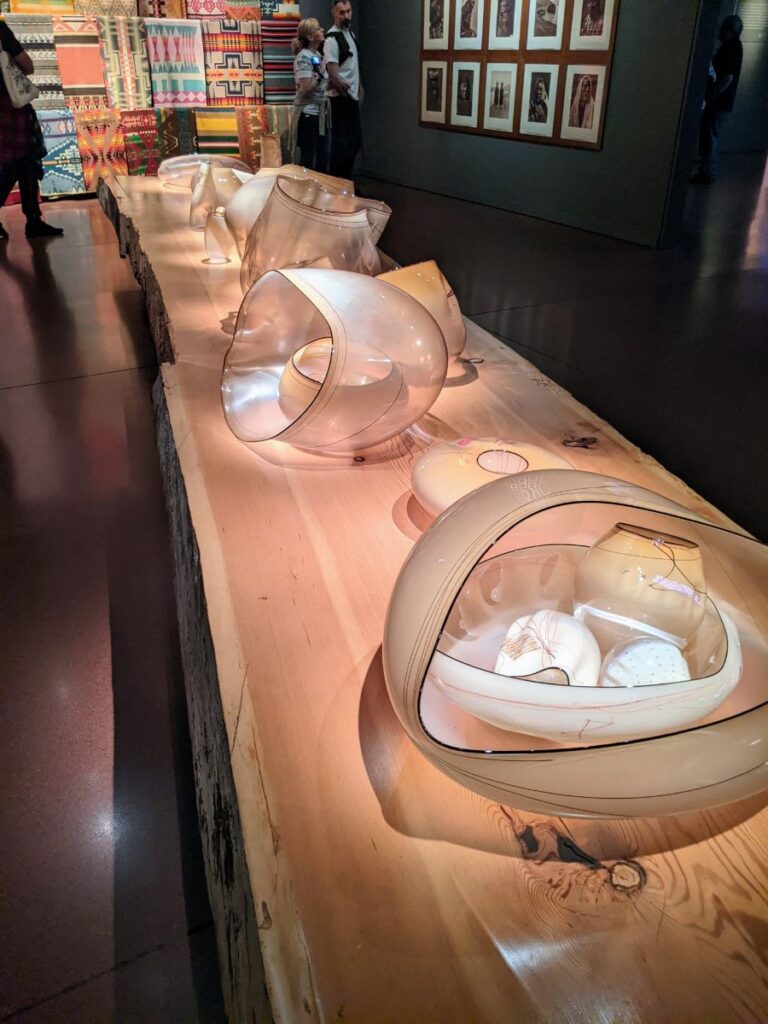
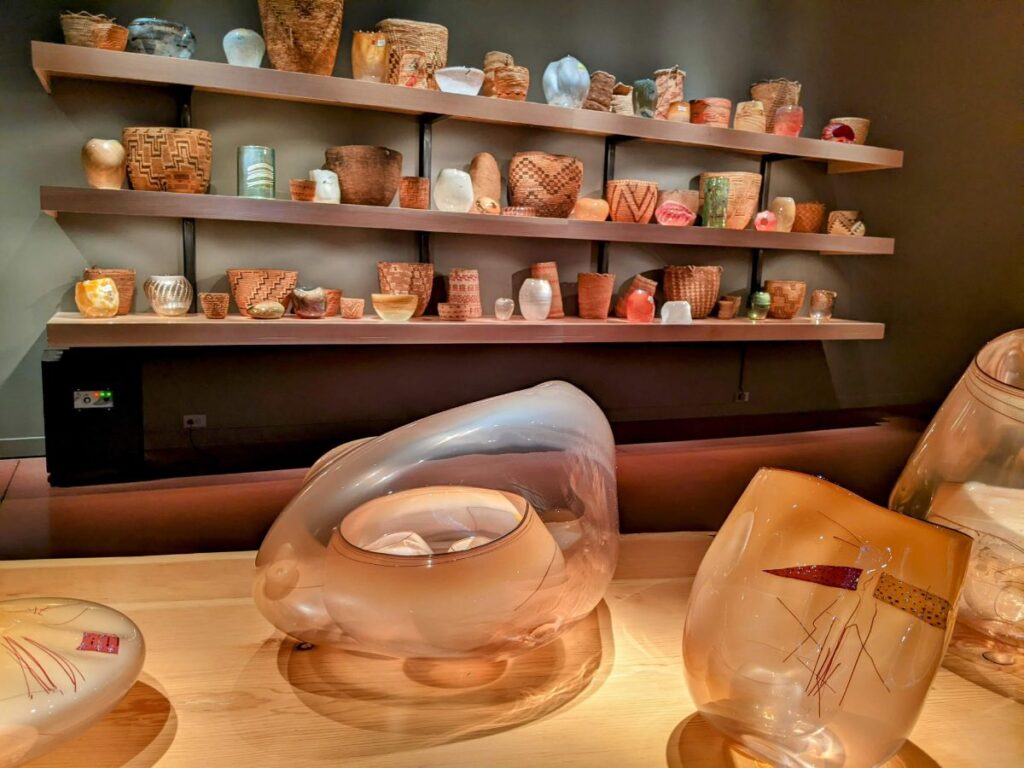
Sealife Room
Exiting the muted colors of the Northwest Room, you turn to enter the dark walls and bright blue tower of the Sealife Room. The central Sealife Tower is made in the style of Chihuly’s famous chandeliers, with thousands of twisting glass tubes attached to a central structure. Nestled among the mass of tubes, you can spot gold sea creatures like octopi, anemones, shells, and rays.
Around the outside of the room are smaller pieces, completed as studies on a smaller scale.
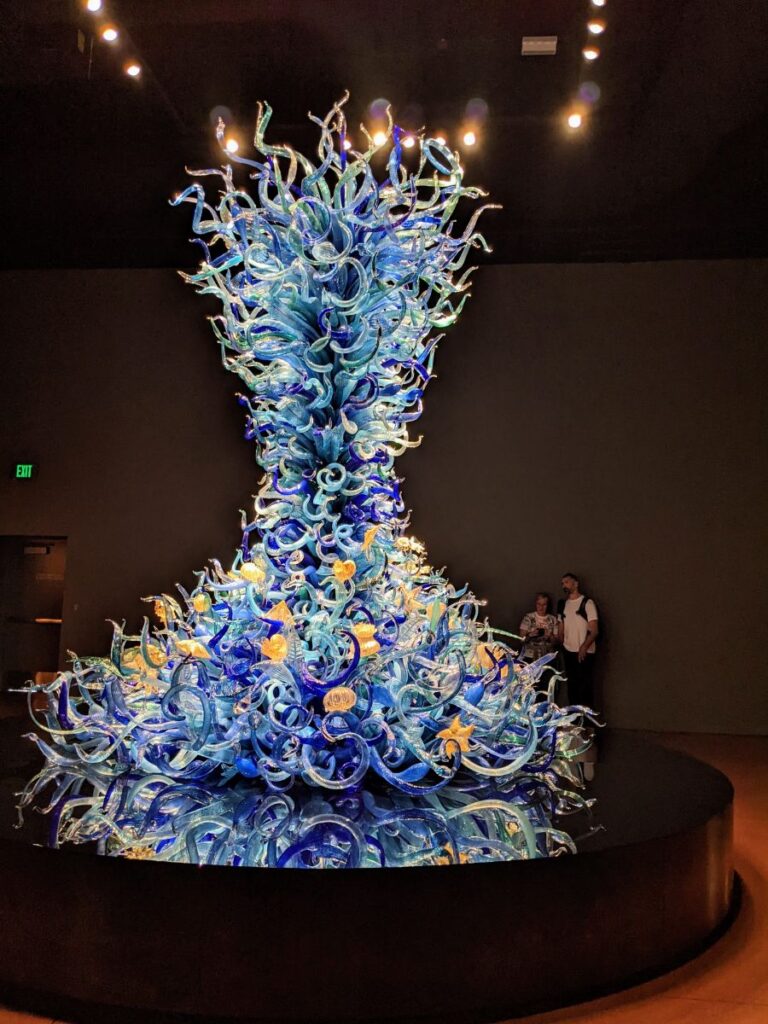
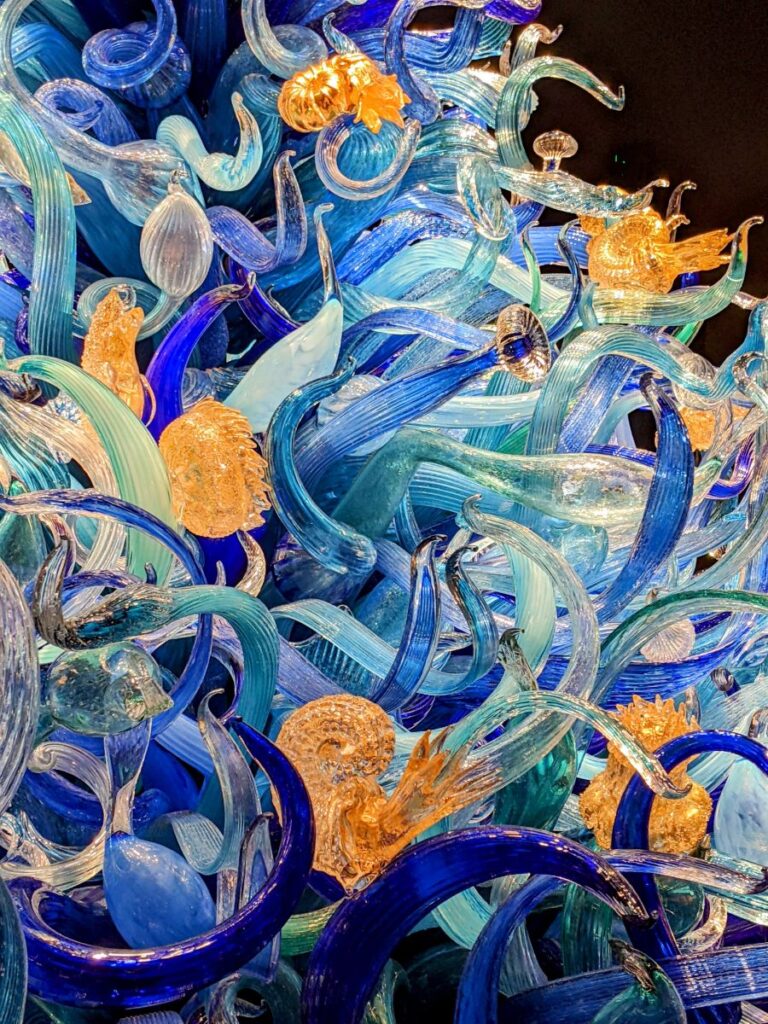
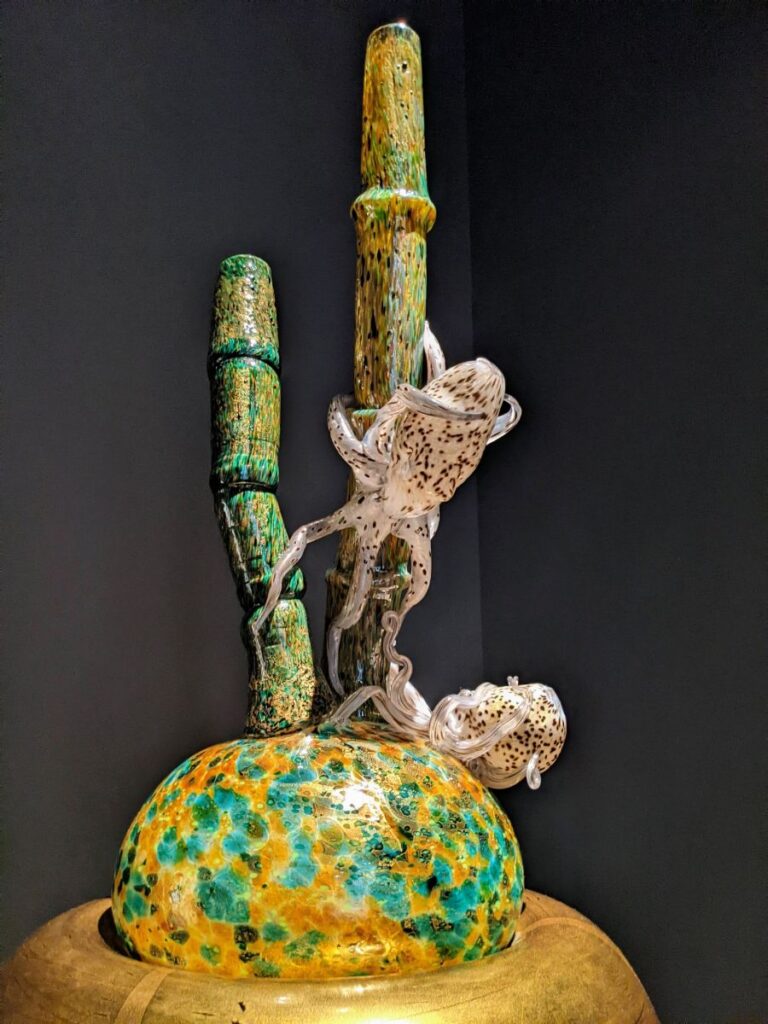
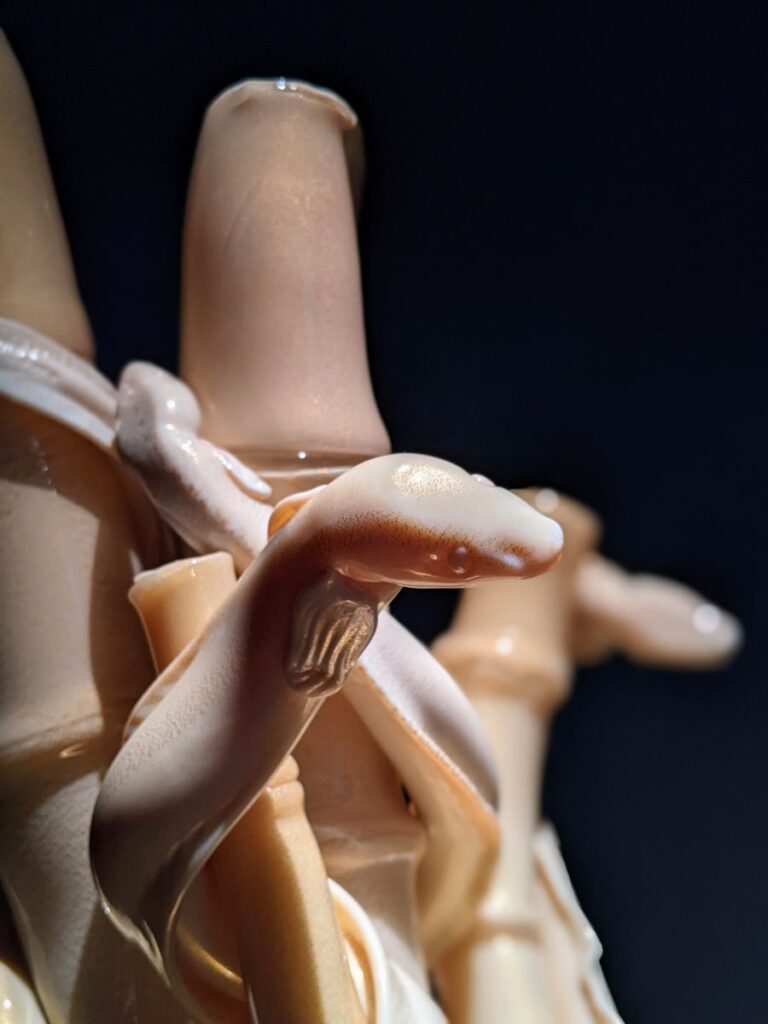
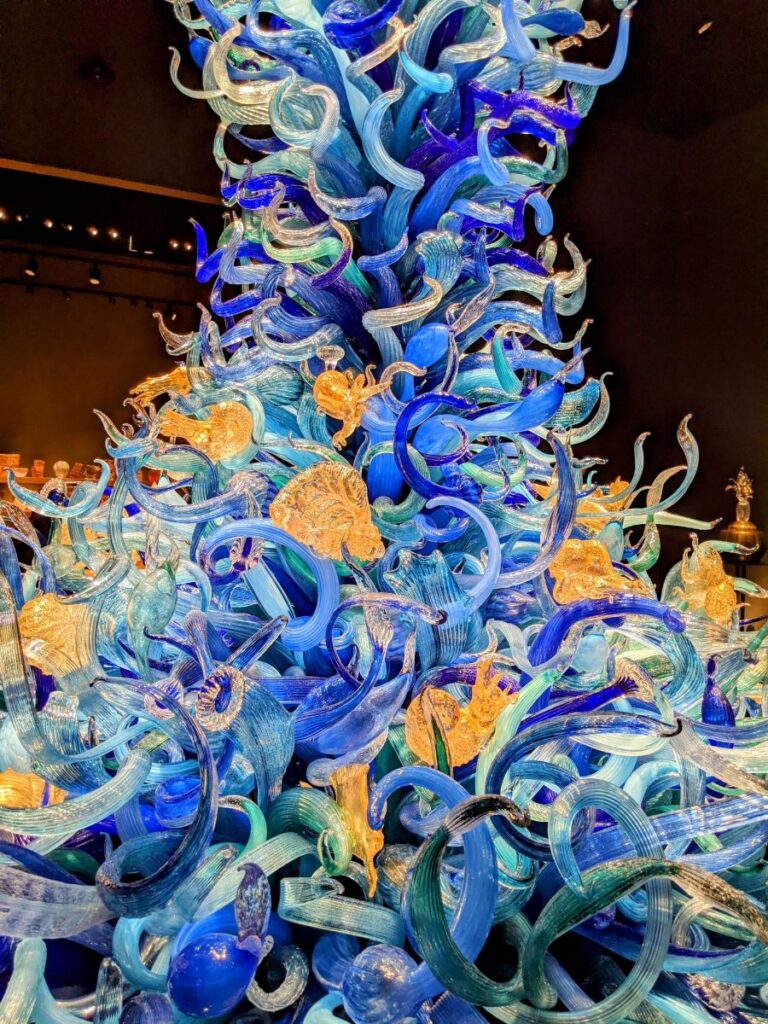
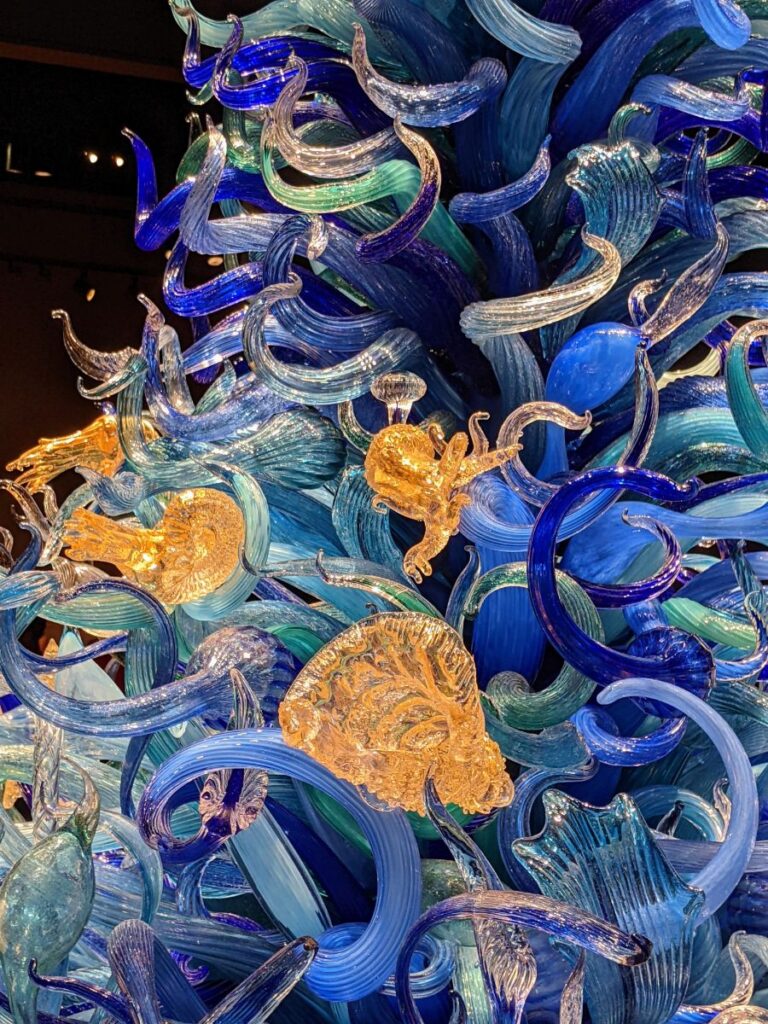
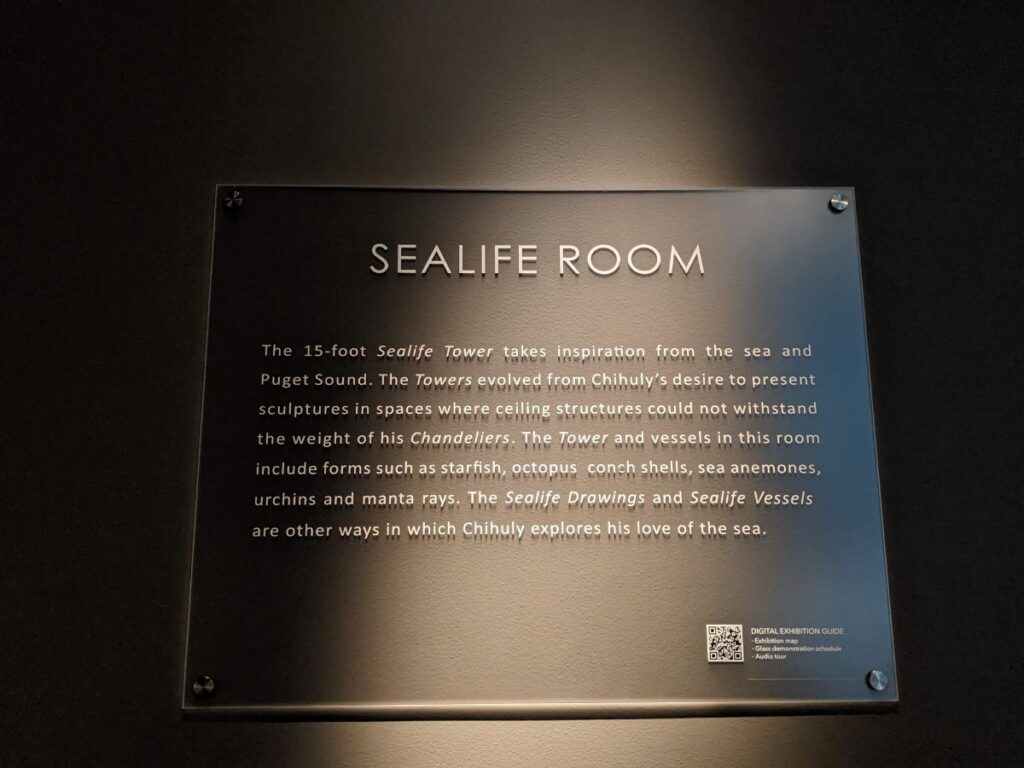
Persian Ceiling
The next turn takes you into a small room lit from above through a mass of smaller colored glass vessels. The Persian pieces are a series on their own, but at some point, Chihuly – ever one to push the boundaries of scale – collected them all into a ceiling installation. Clear glass panes overhead support a huge collection of bowls, discs, squiggly bits, and figures. Light from above the glass objects filters down to visitors below.
This is the only room that makes me want to recreate it in some way at home. To collect random colored glass from flea markets and set it up over an old window in an outdoor patio. (I guess that sounds more like an Appalachian Ceiling, but hey.)
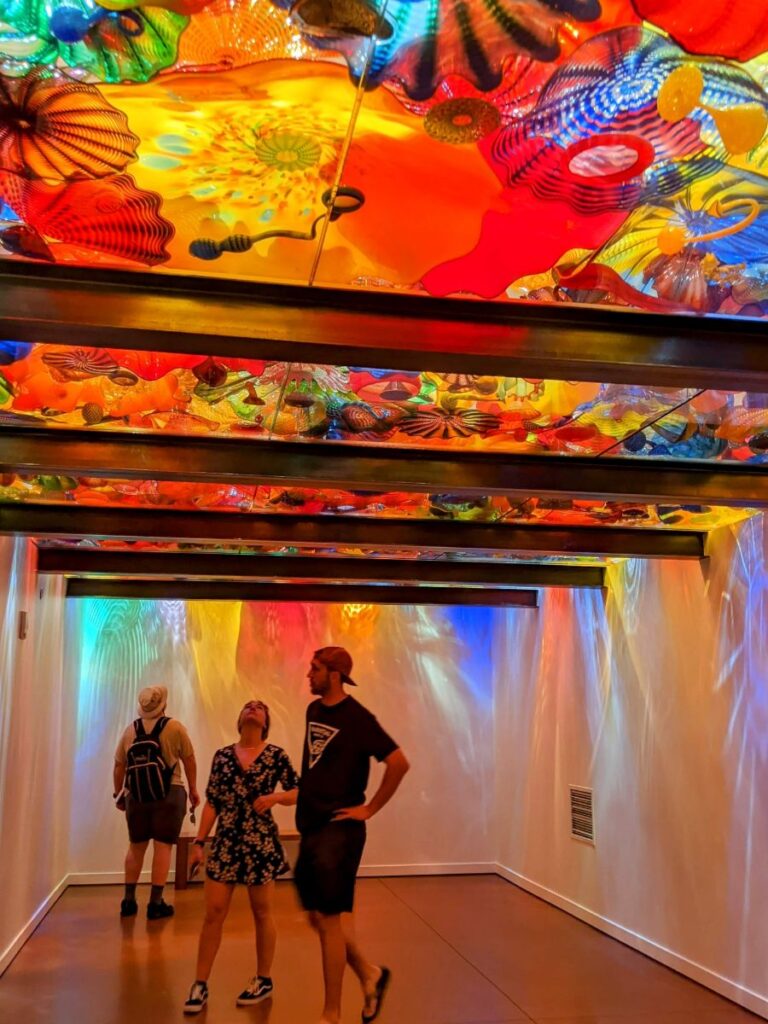
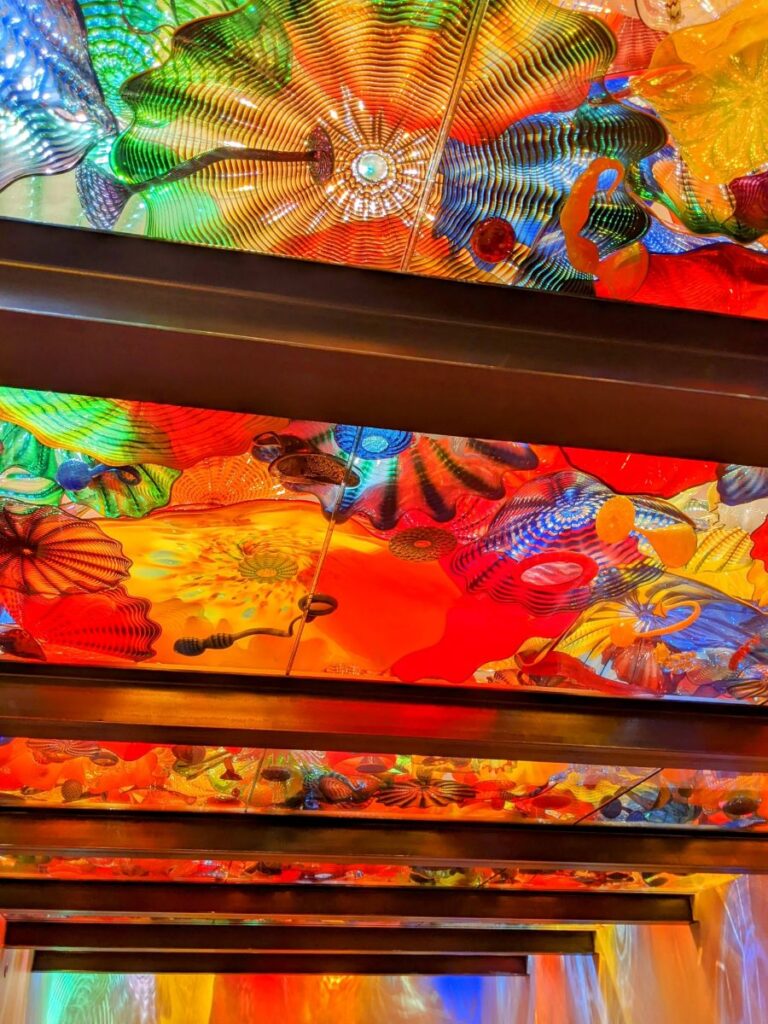
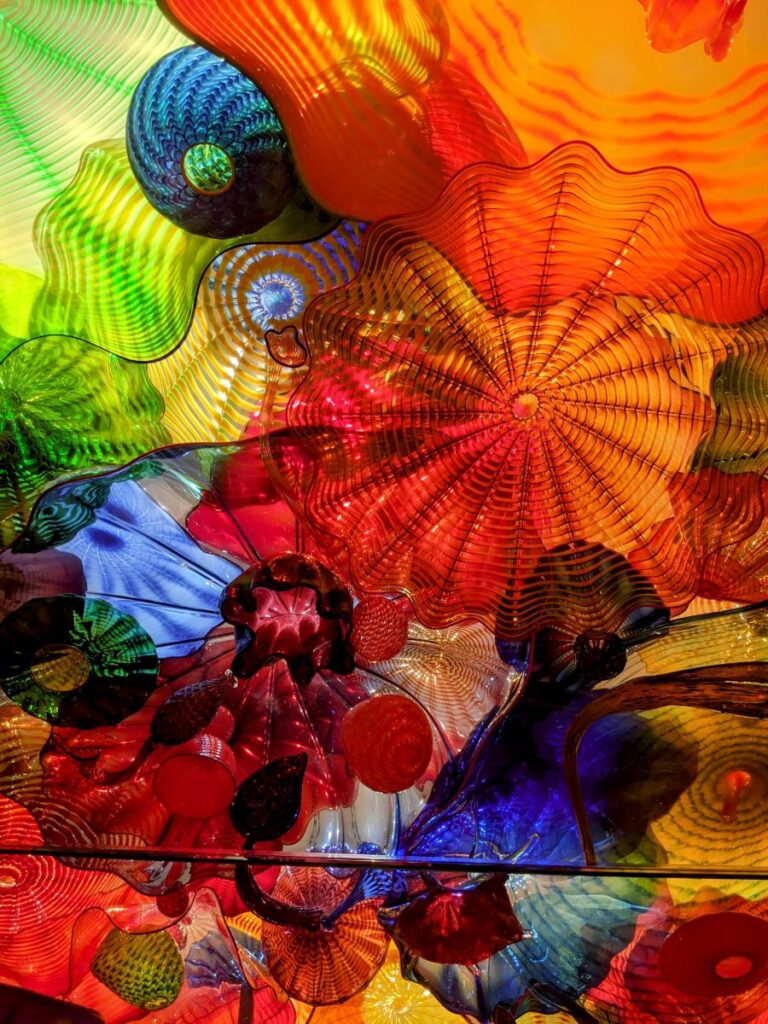
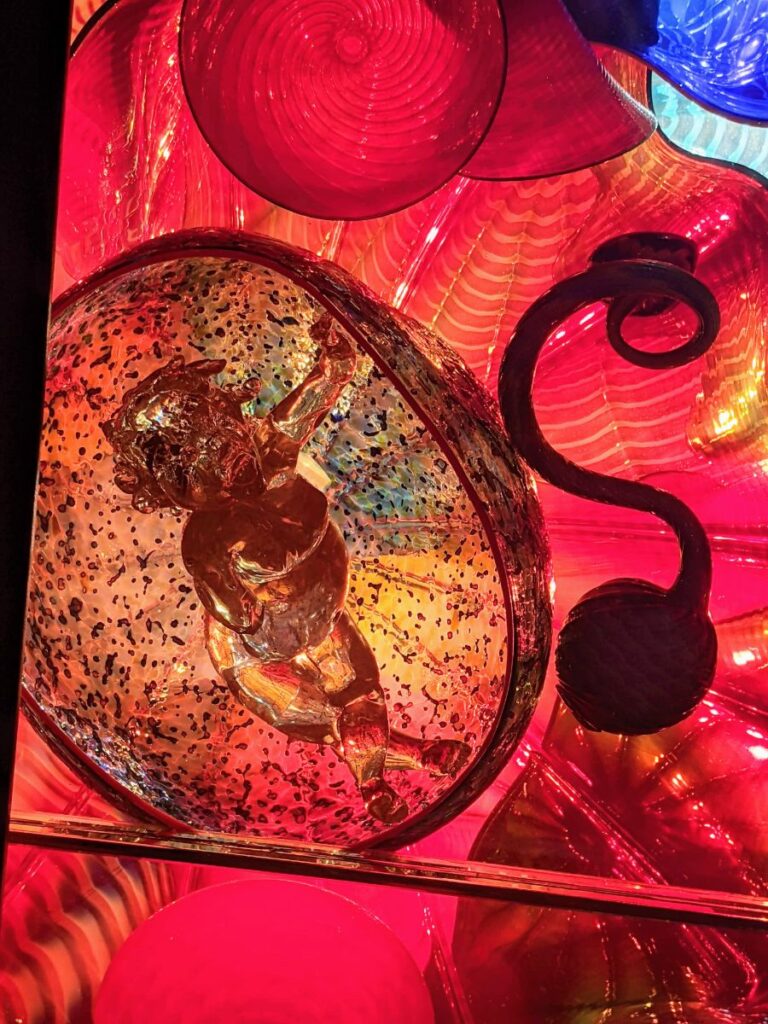
Mille Fiore
The biggest room at Chihuly Garden and Glass contains Mille Fiore – Italian for “a thousand flowers.” This super-saturated garden of glass features spikes, globes, spires, and fans in an unworldly display that would look appropriate in a surreal under-the-sea setting.
This one really blows you away right when you walk in. As such, sometimes a little crowd gathers at the entrance to get “the shot.” But as you walk around the installation, there are many great aspects from which to view it.
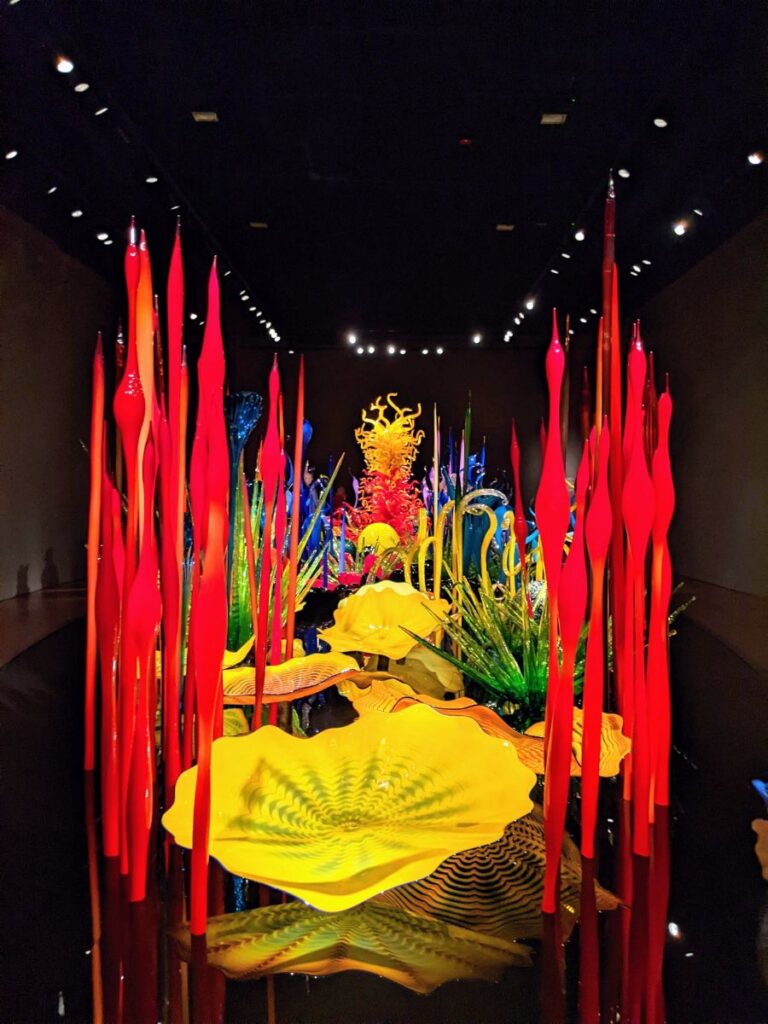
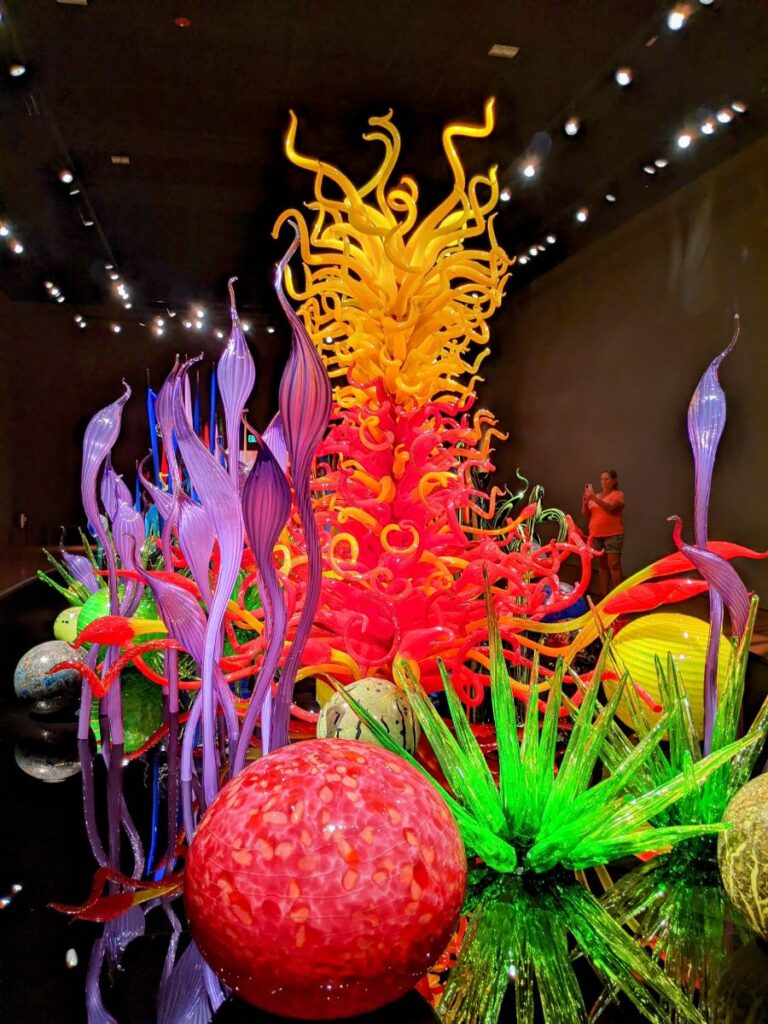
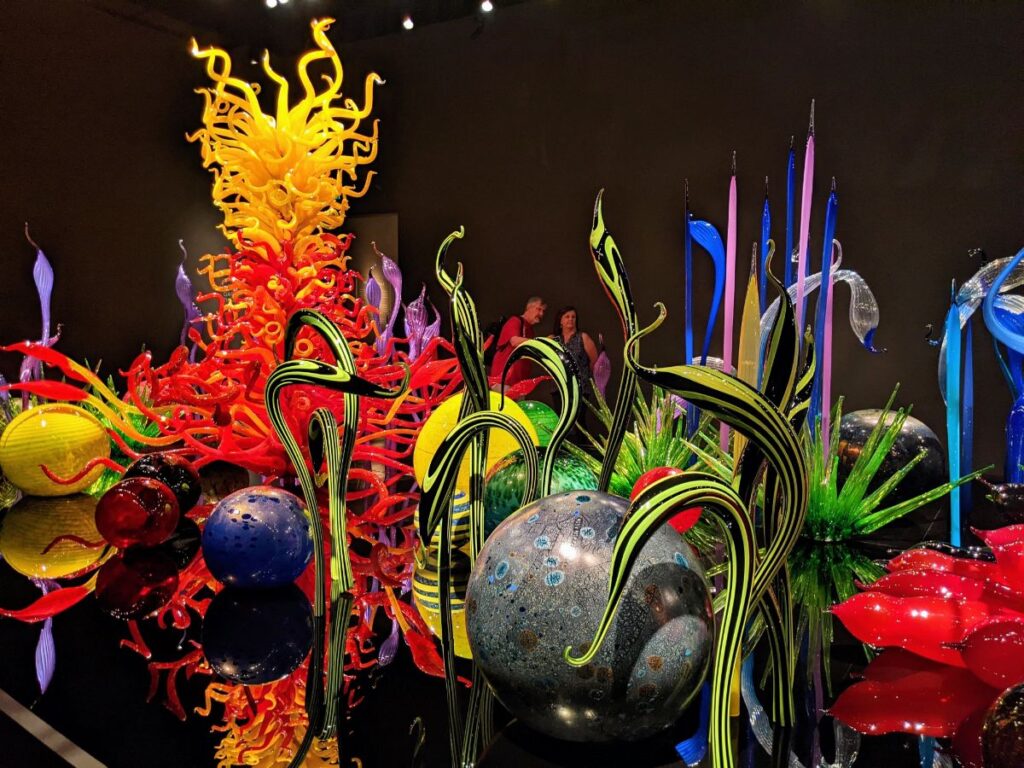
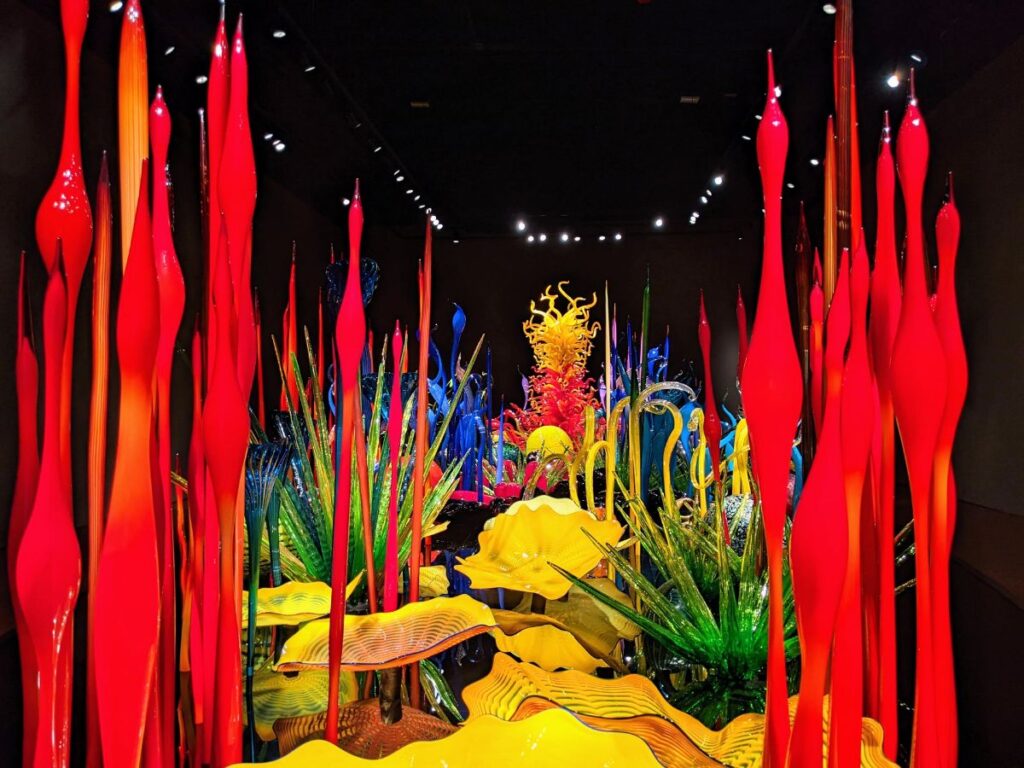
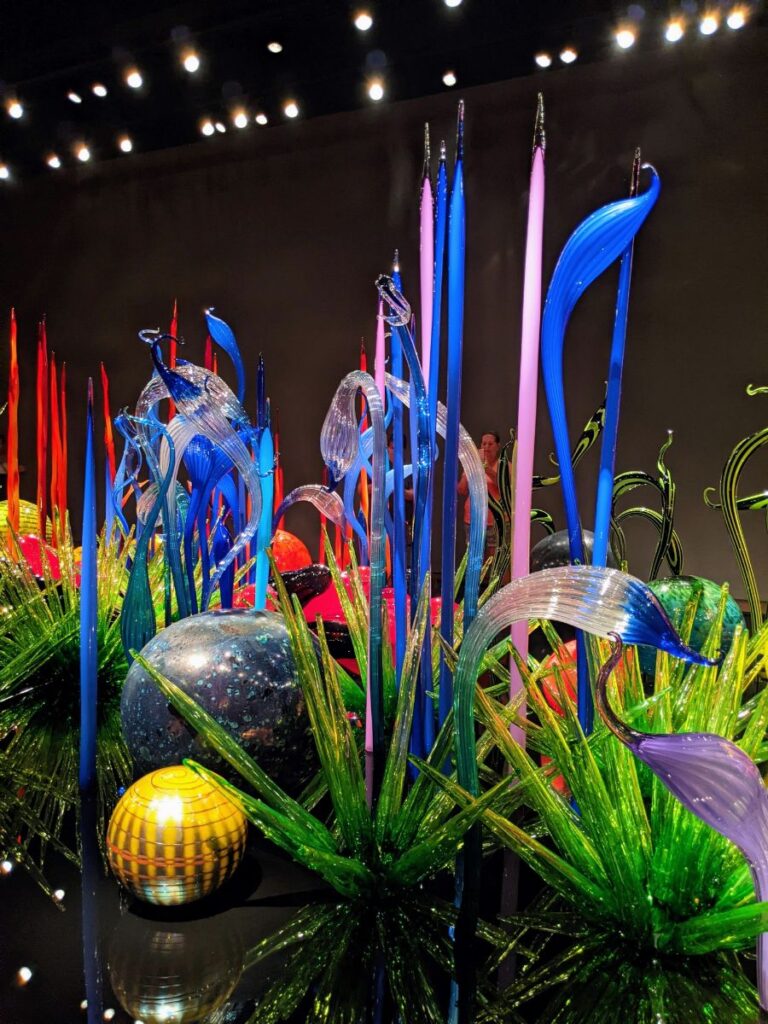
Ikebana & Float Boat
Rounding the corner from the Mille Fiore room, you face two small rowboats. One is filled with long, spikey, and round shapes. This is the Ikebana Boat, named for the Japanese art of flower arranging. The other has glass globes and is called Float Boat. Chihuly originally floated the large glass balls on the water of an installation he did in Finland, but local teens kept scooping them into a boat on the water, inspiriting him to stage them this way instead.
On the opposite wall are drawings Chihuly started doing after he hurt his shoulder and couldn’t do some of the physical glasswork himself anymore. Prints of watercolor, metallic paints, and even blowtorch marks conveyed his ideas to his team, then became artworks in themselves.
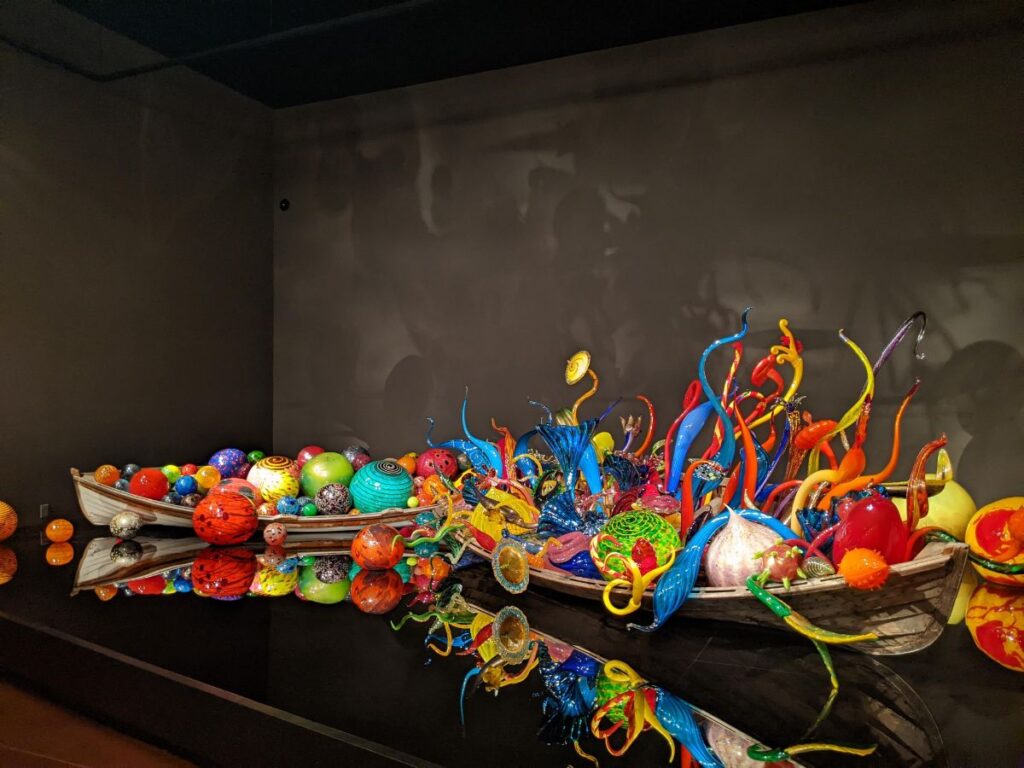
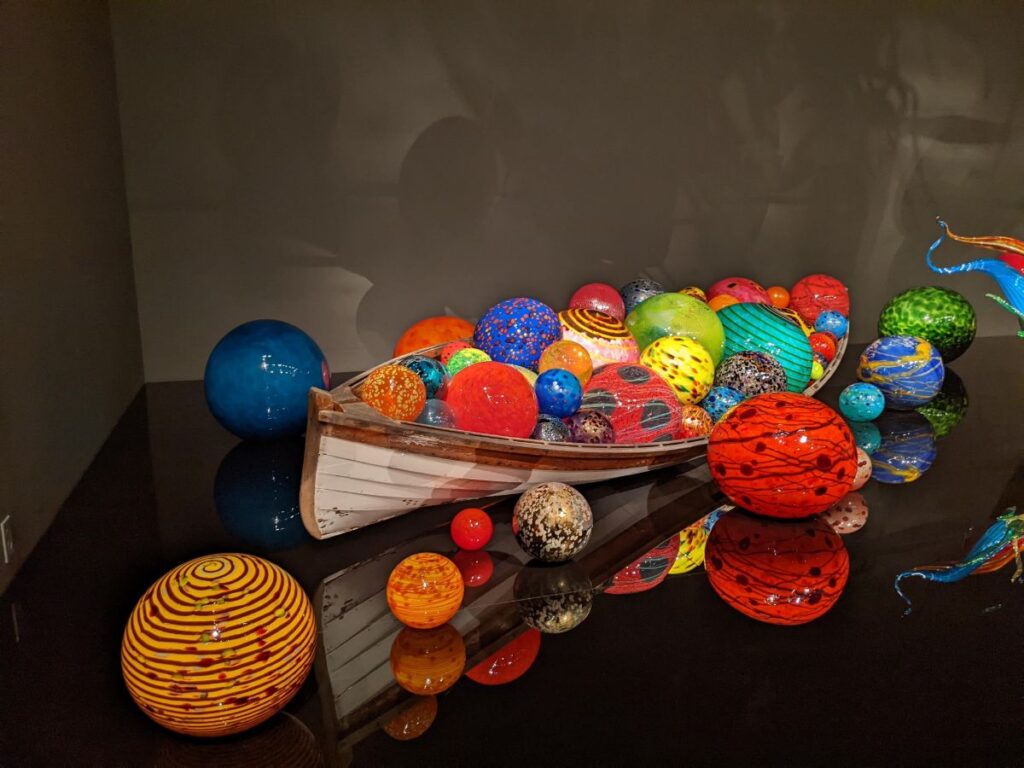
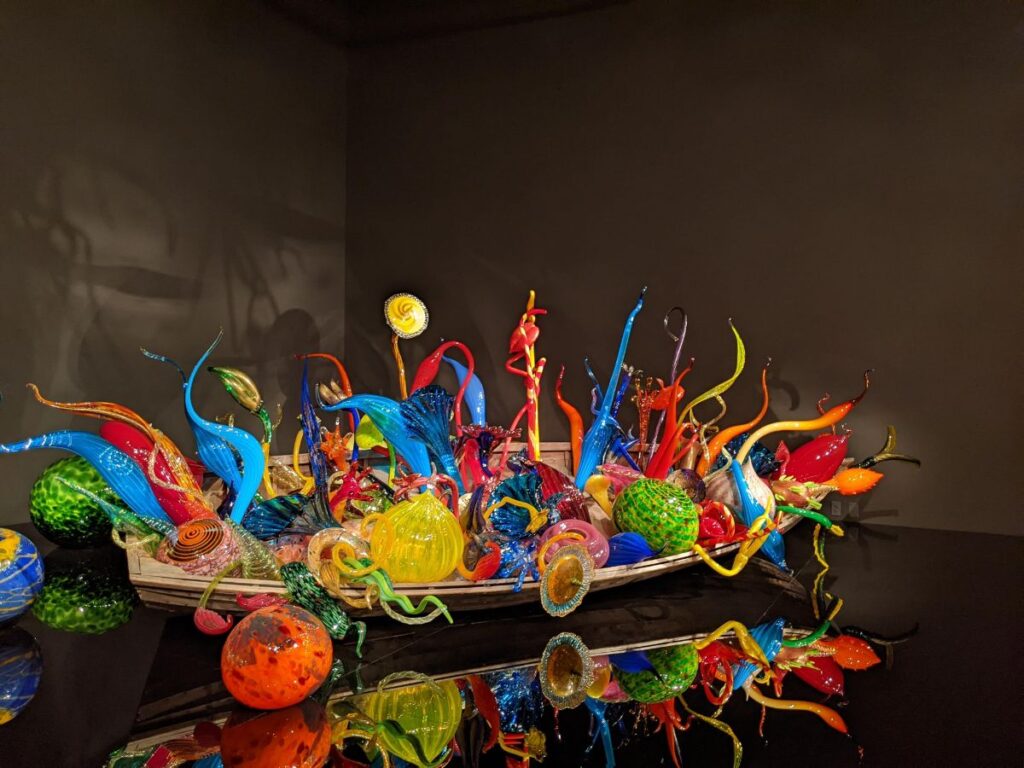

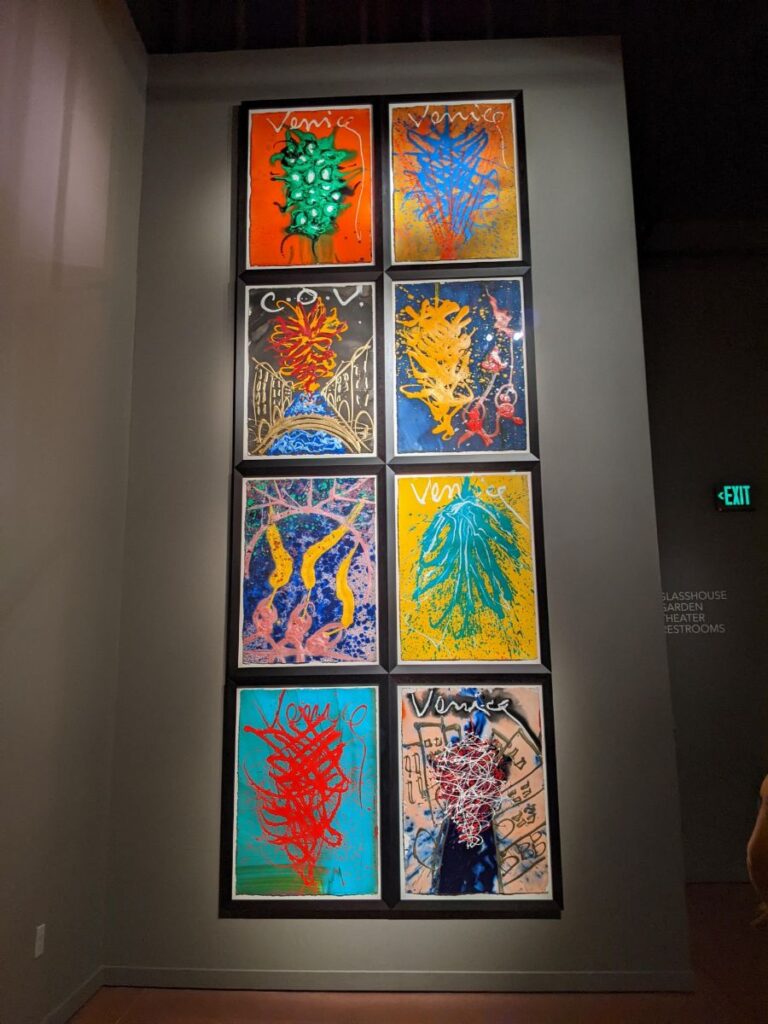
Chandeliers
Dale Chihuly is arguably most famous for his chandeliers, which is mostly what you see of his works “in the wild,” AKA, outside of a museum. And the chandelier room at Chihuly Garden and Glass is arguably the most boring room in the place.
I am surprised by the variety in the chandeliers. There’s far more variation than what I think of as the stereotypical Chihuly chandelier. But still, the room is pretty bare with spotlights on a few works.
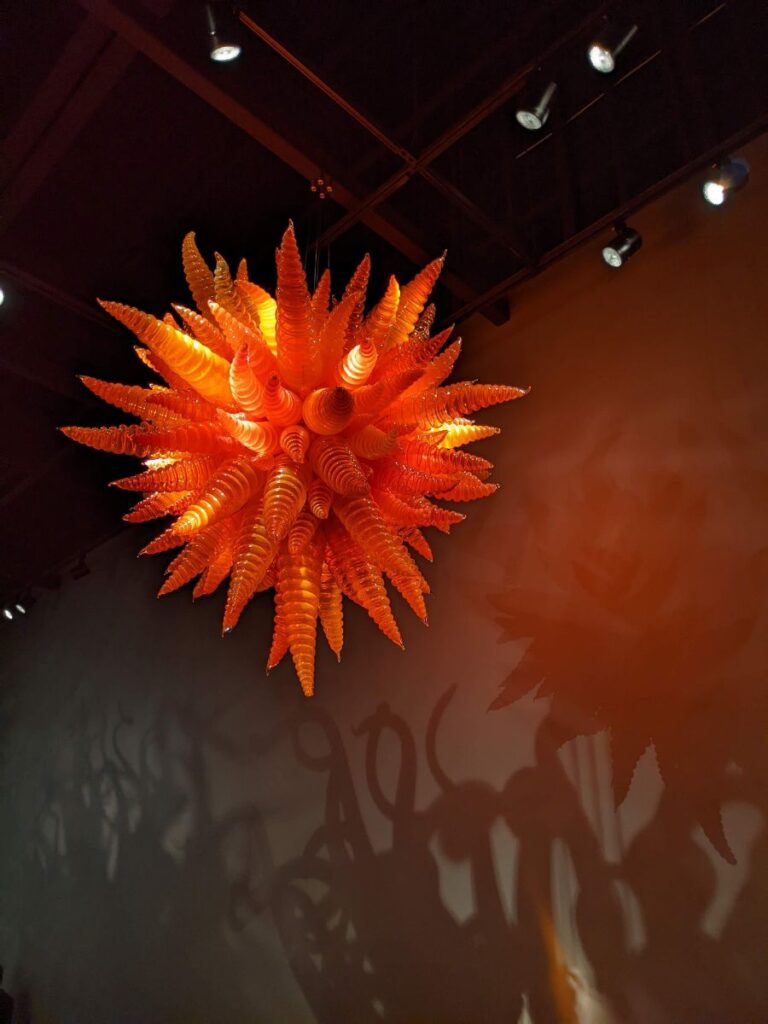
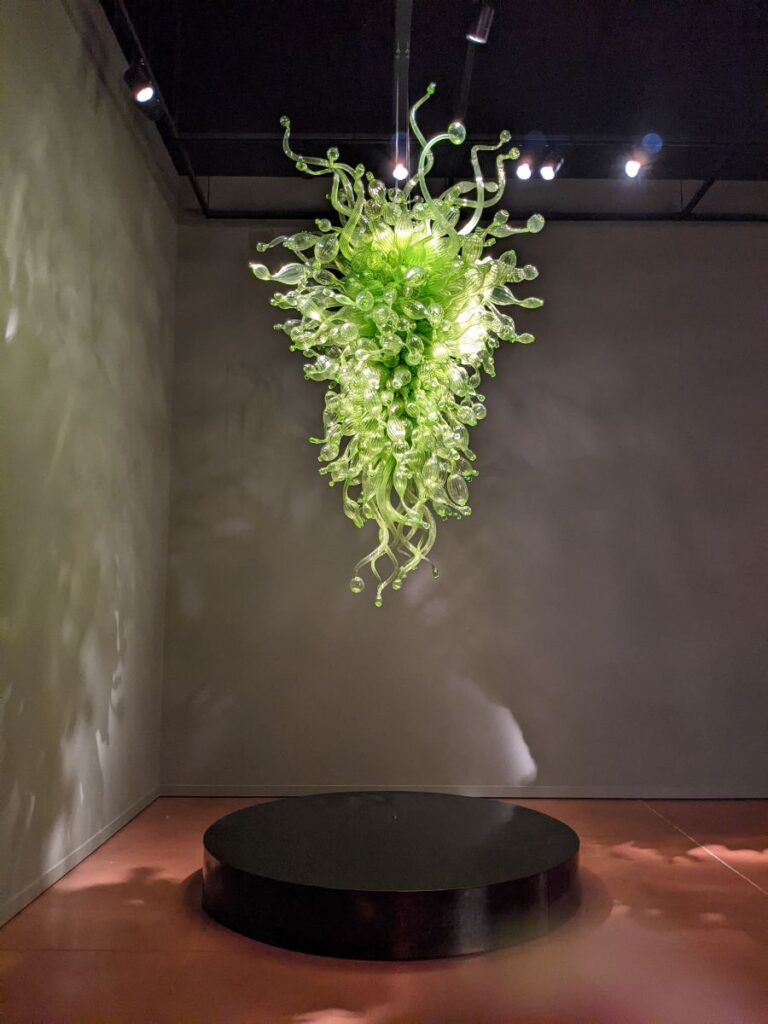
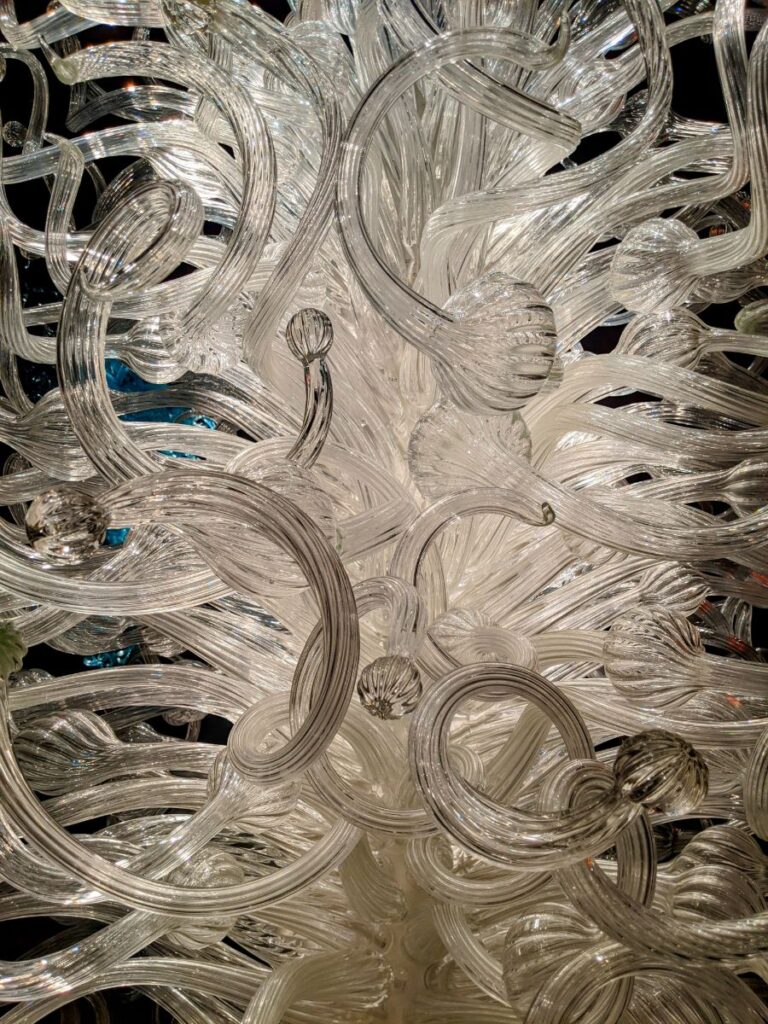
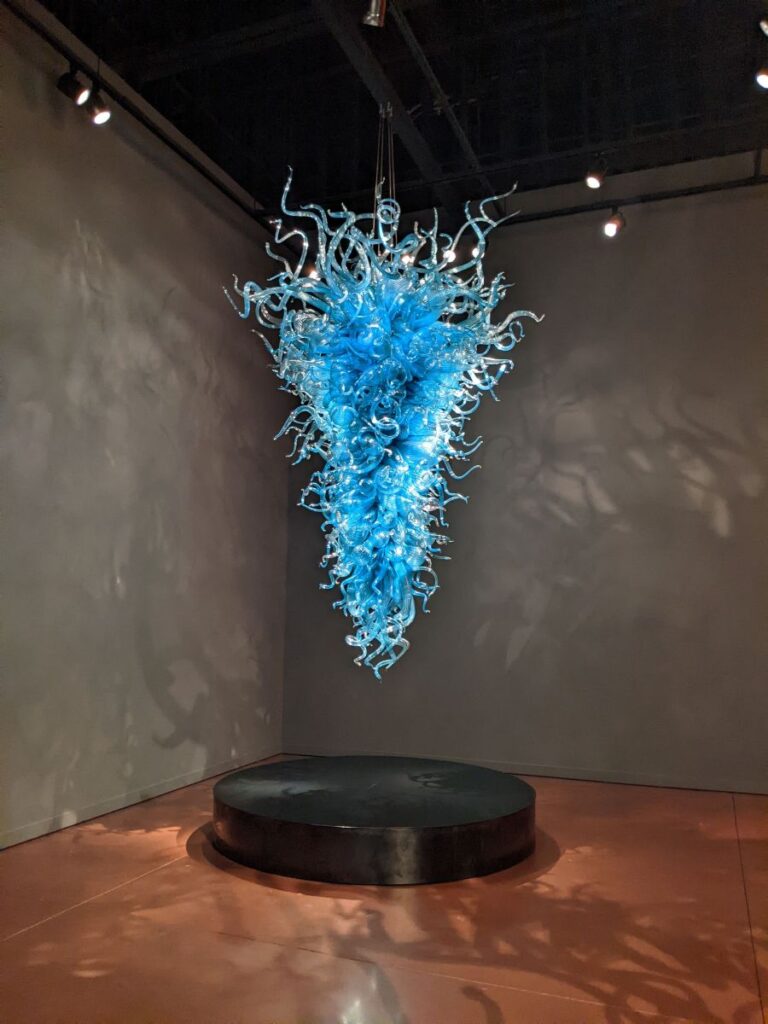
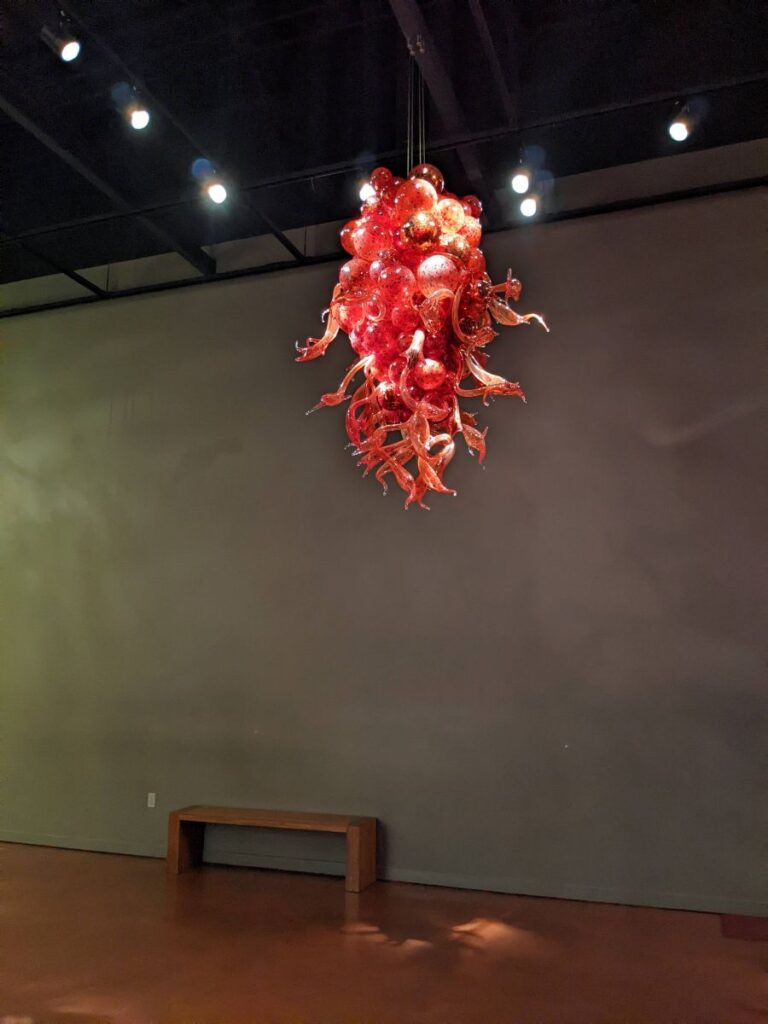
Macchia Forest
Next is a surprising favorite of mine, the Macchia Forest. It’s a small room with hyper-colorful bowls that look like they’re lit from within. Chihuly figured out that he could layer cloudy white between the outer layers to make the colors show up more brightly.
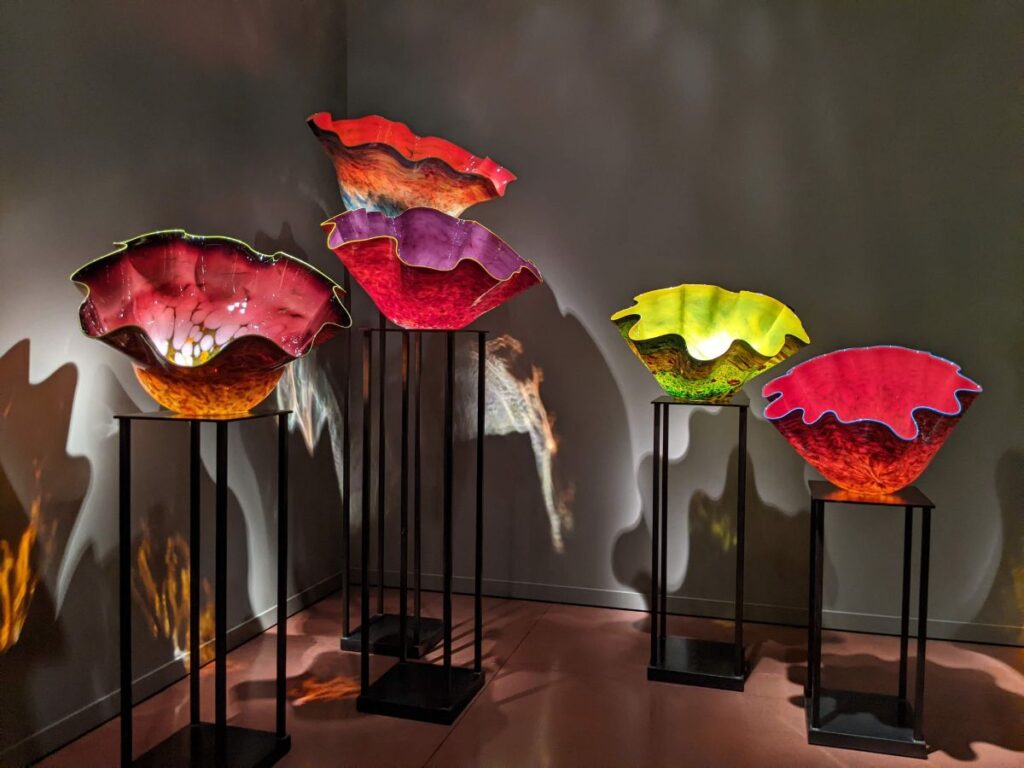
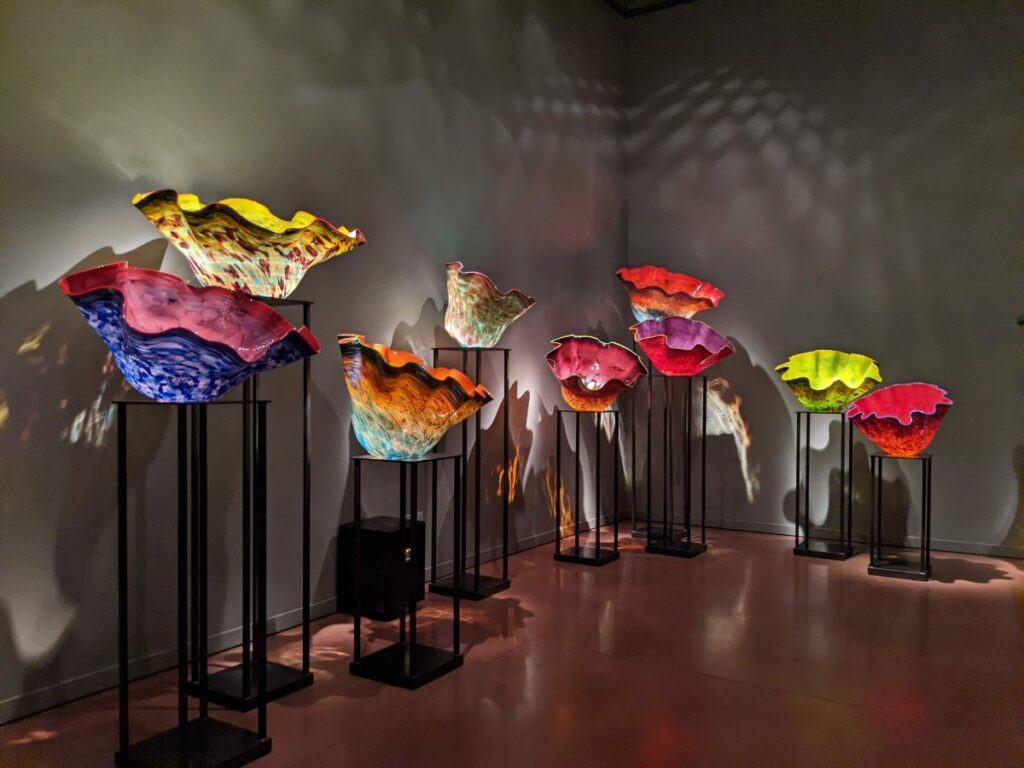
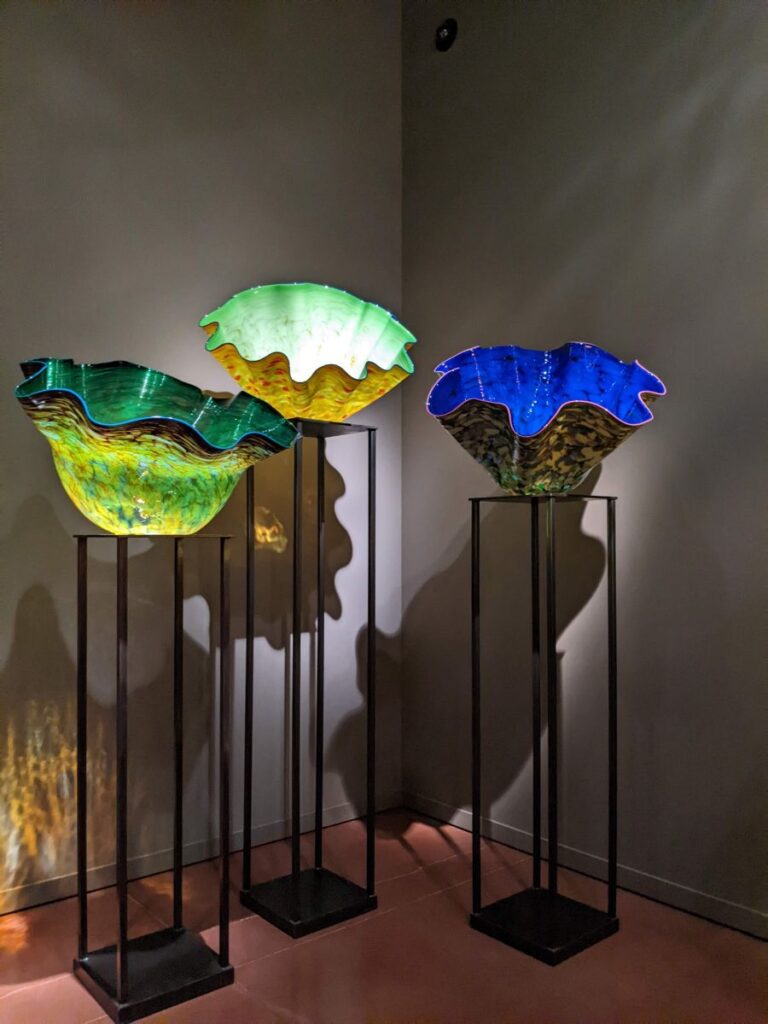
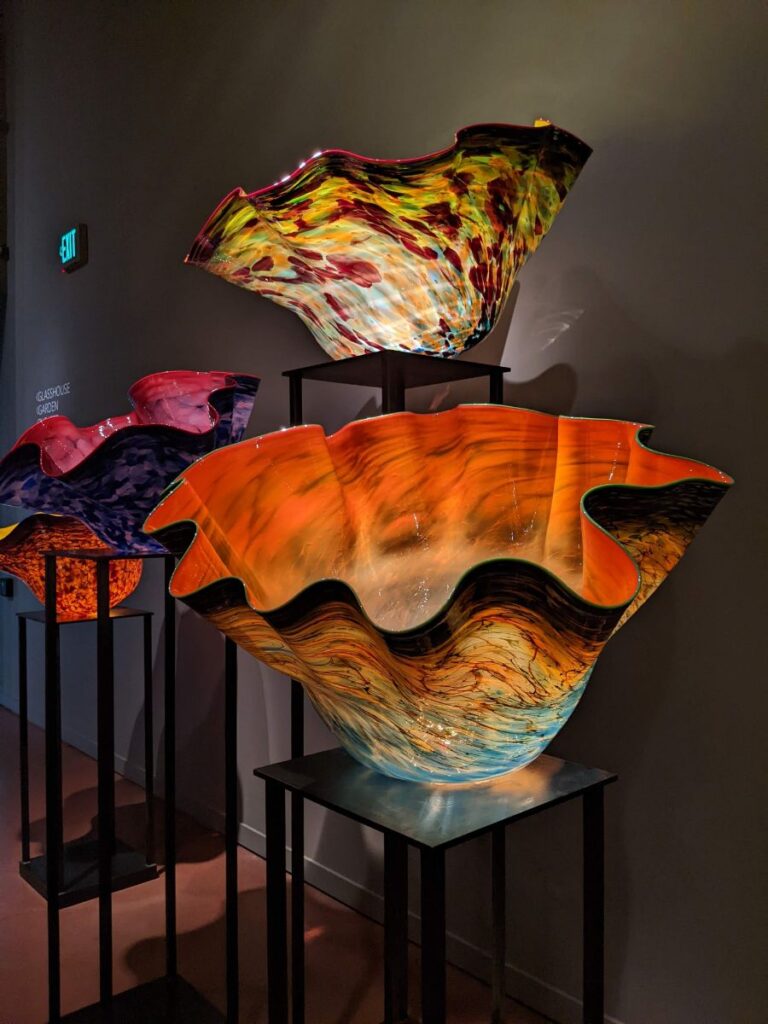
Glasshouse & Garden
Next, we finally head outside – or almost. Back here are more bathrooms and a museum cafe – more on that later. There’s a hallway with some historic photos of Dale Chihuly that leads to a huge glass conservatory room with a likewise massive flower installation hanging from the ceiling. Again, this is placed in such a way as to really wow when you first walk in.
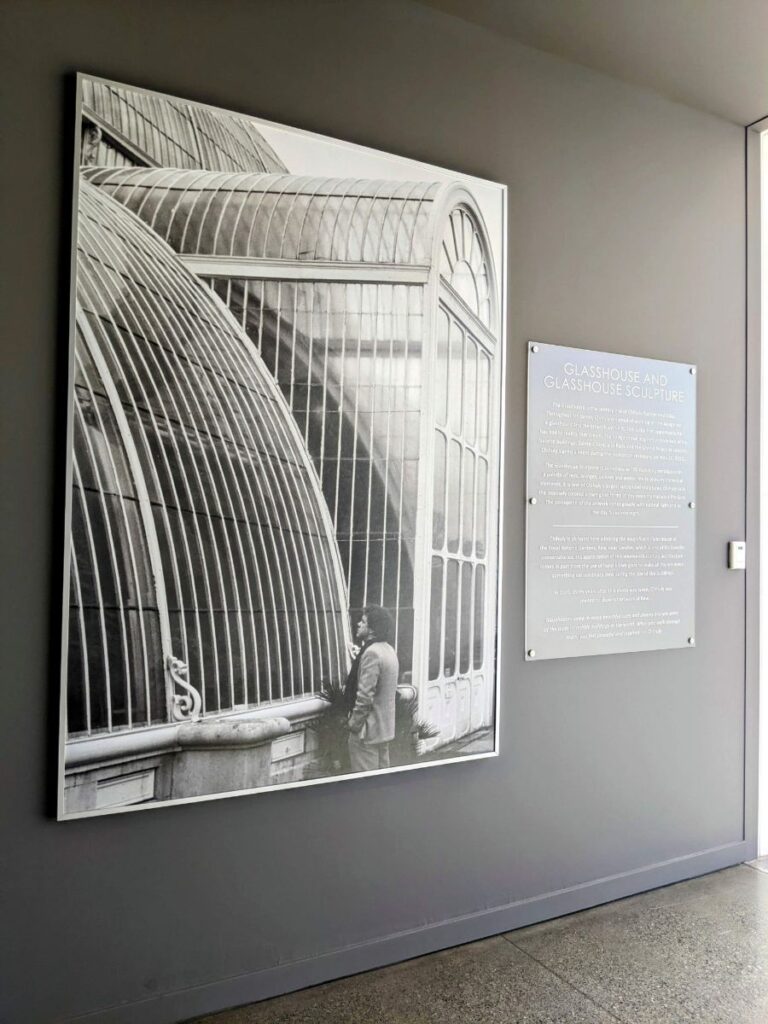
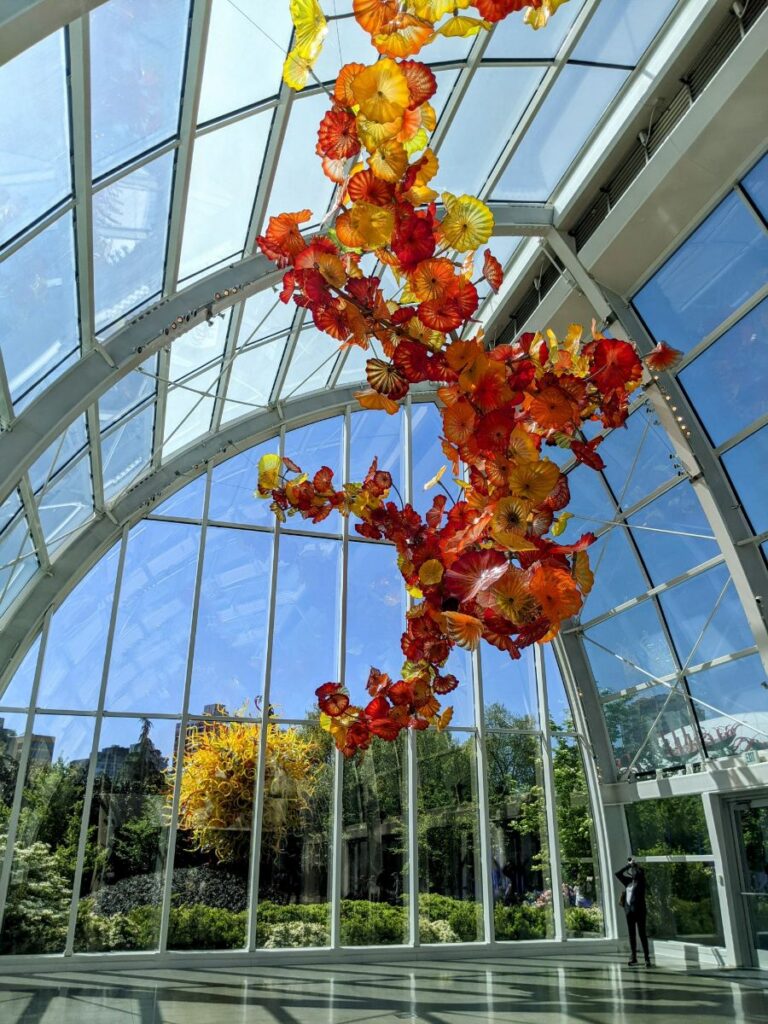
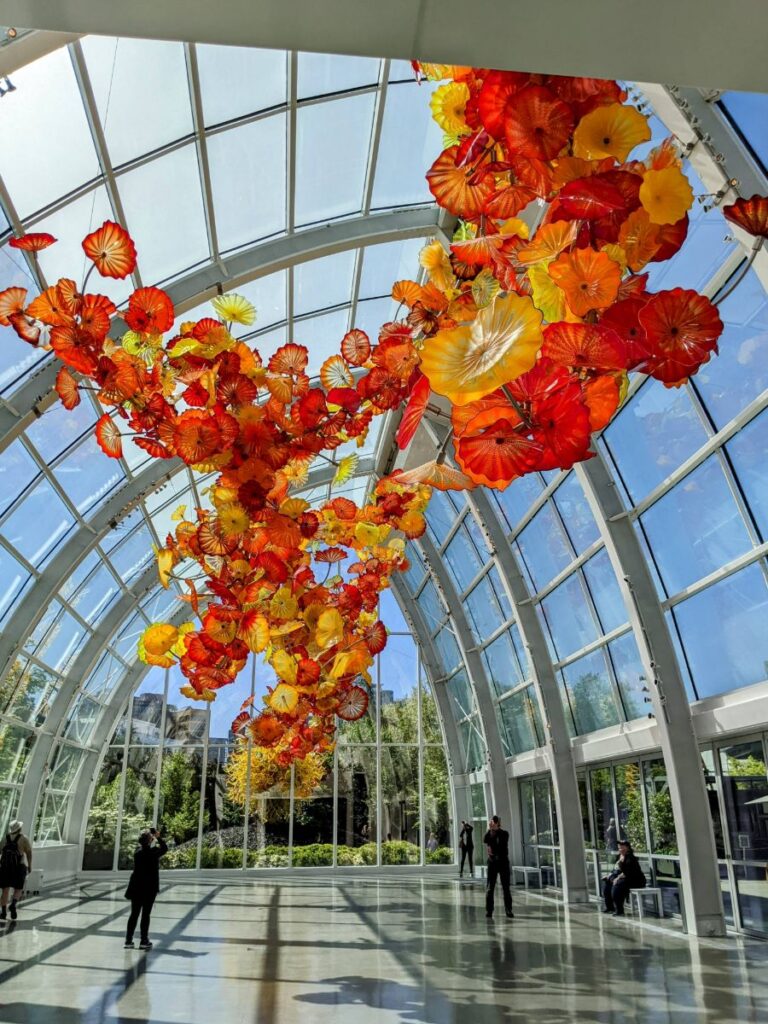
Two different exits from the Glasshouse lead to an outdoor garden, which is filled with spikes and tendrils and globes. A large chandelier-style pedestal installation forms a focal point at the end of the Glasshouse, and the Space Needle looms large overhead.
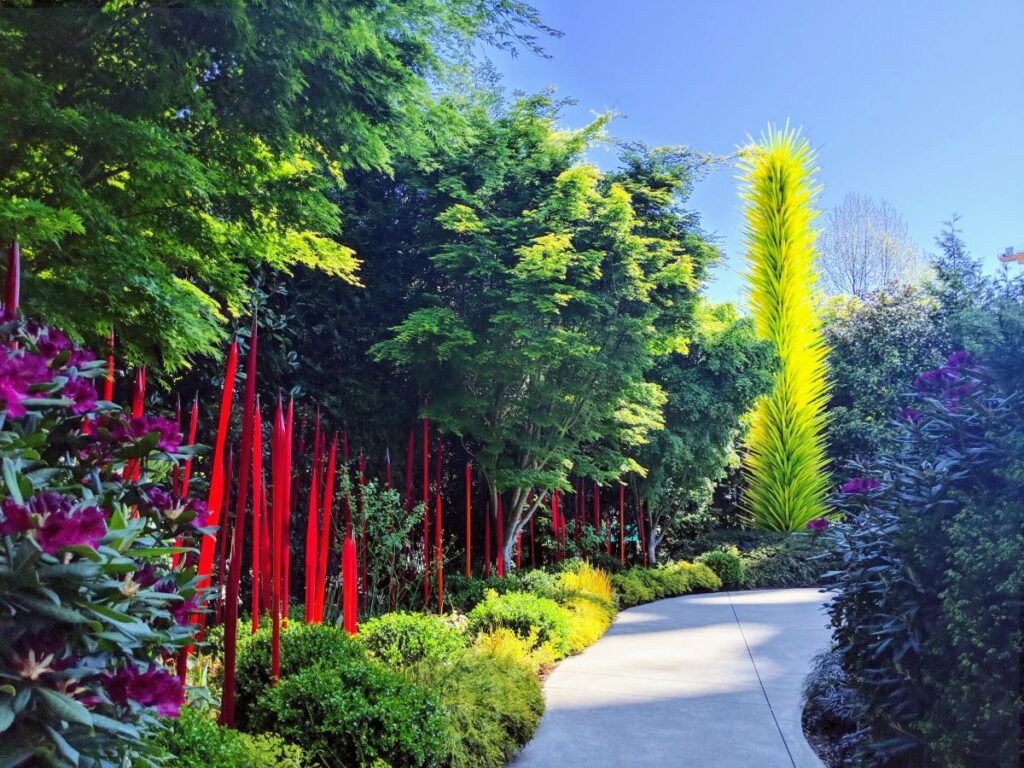
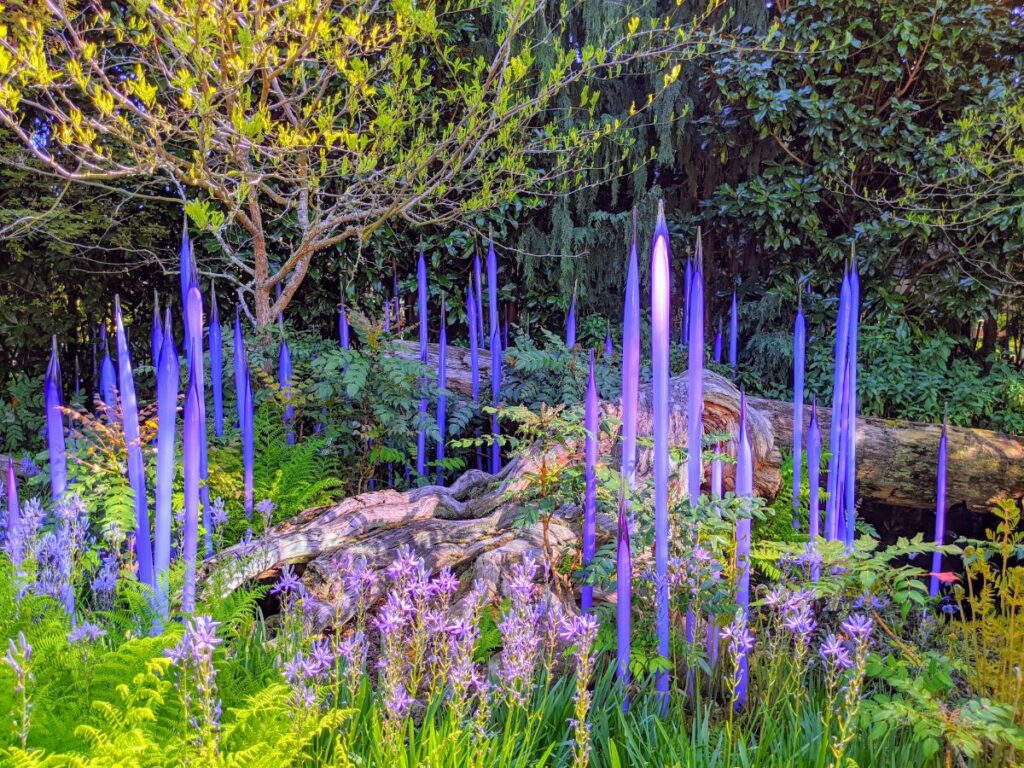
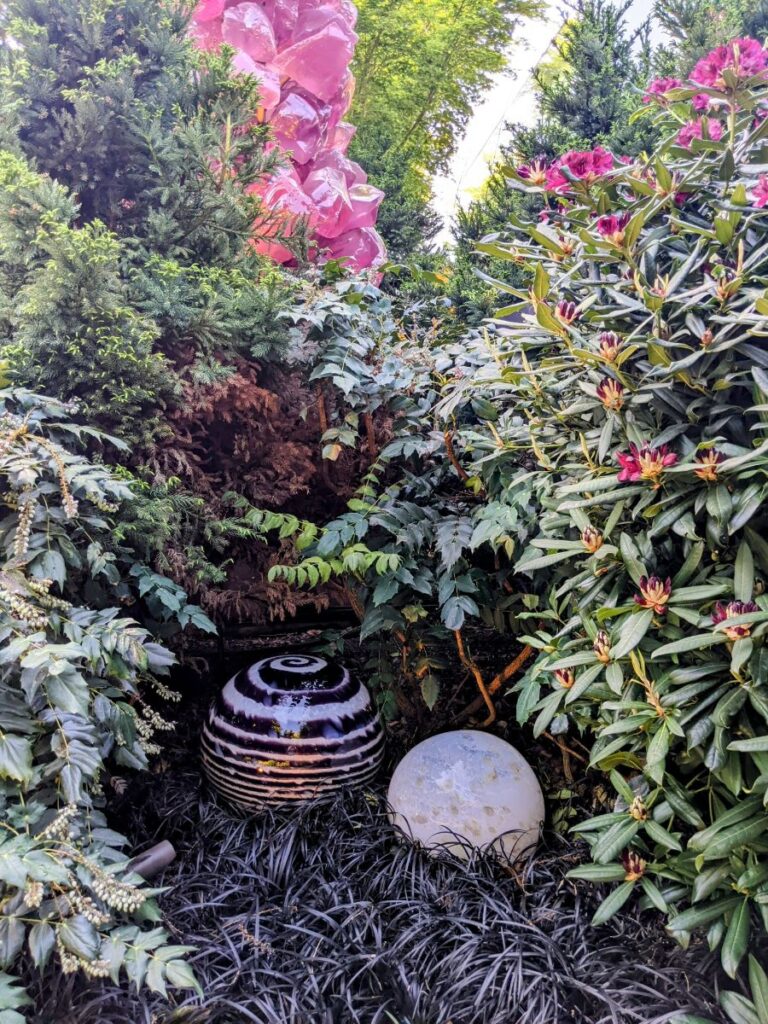
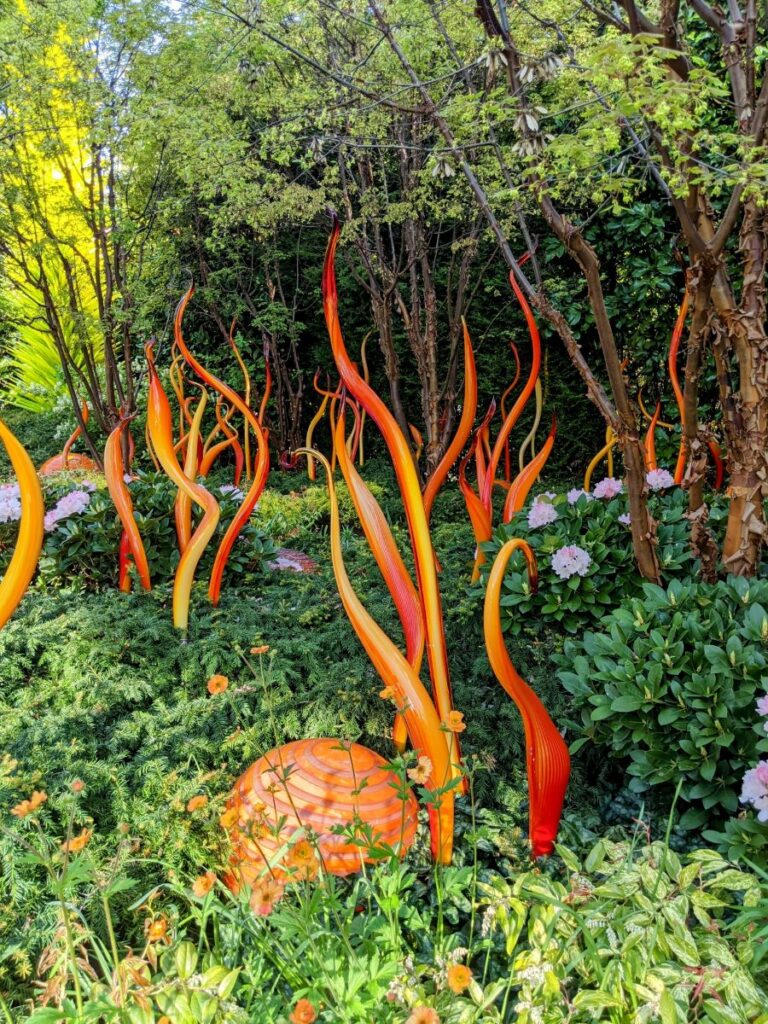
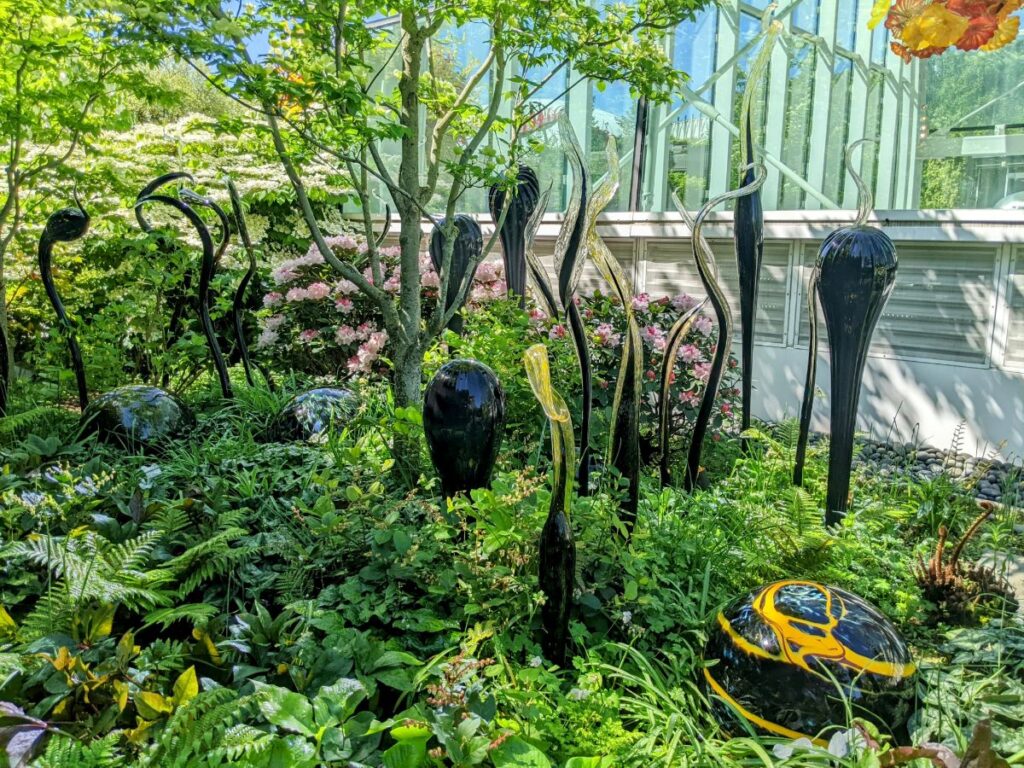
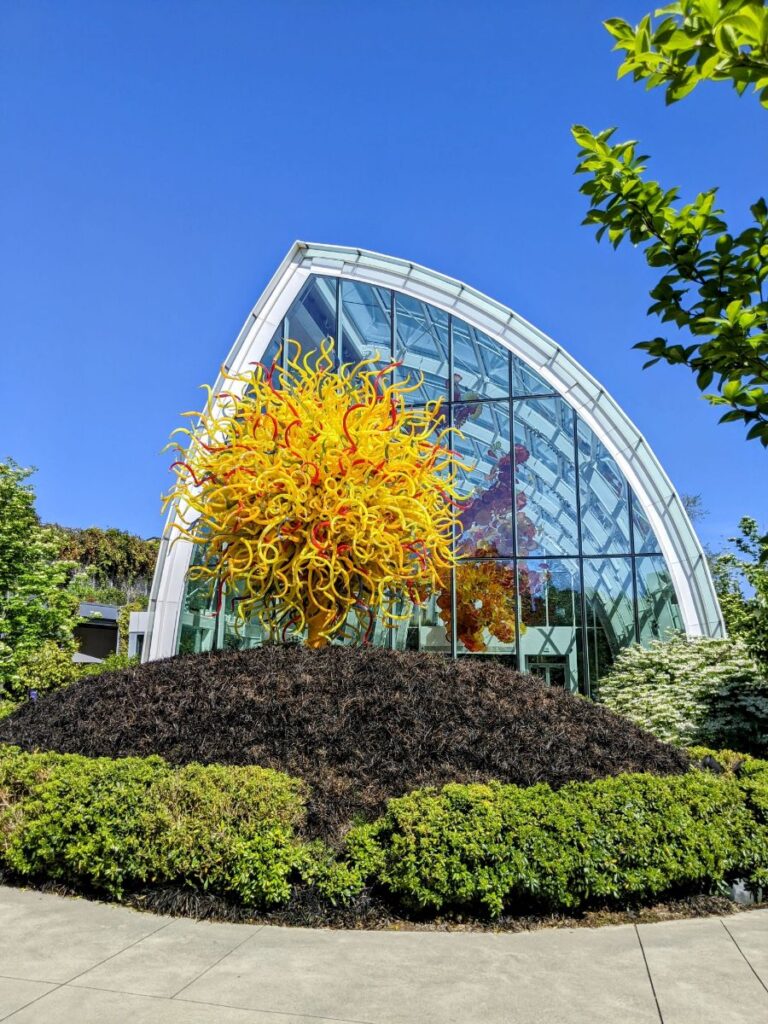
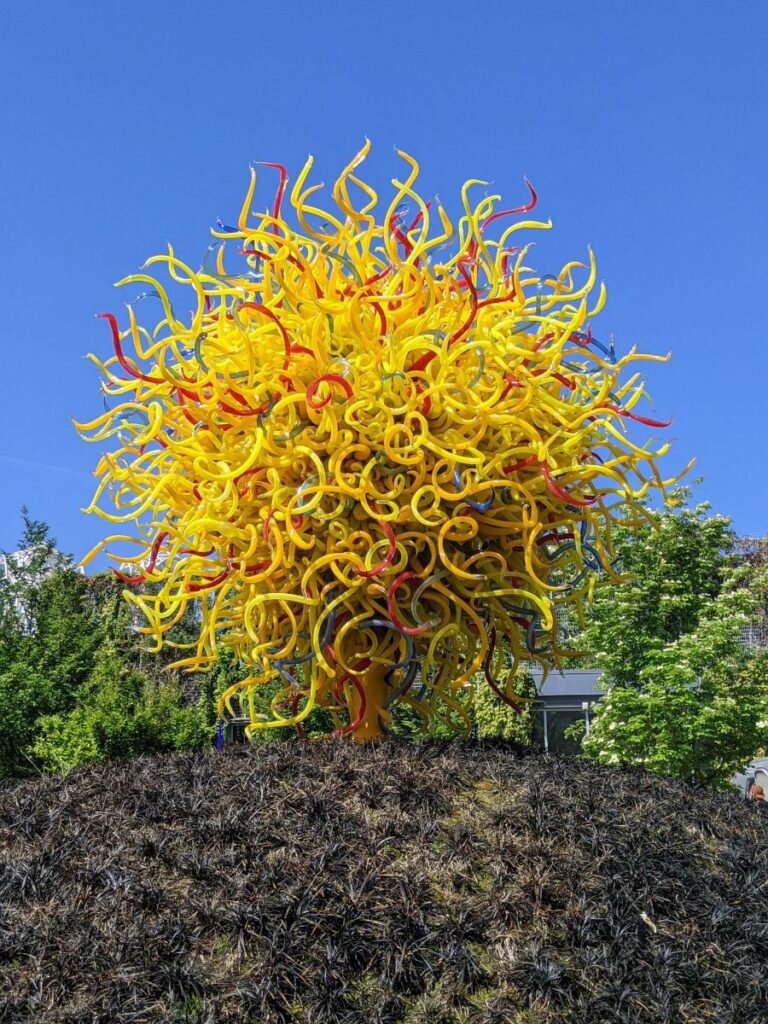
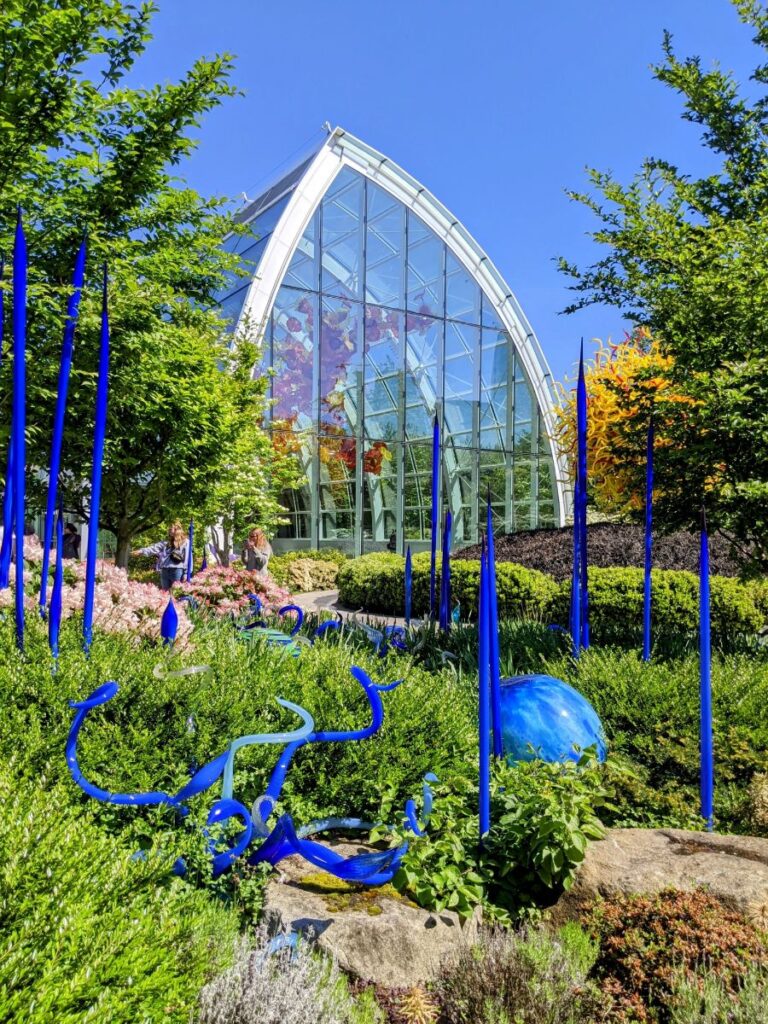
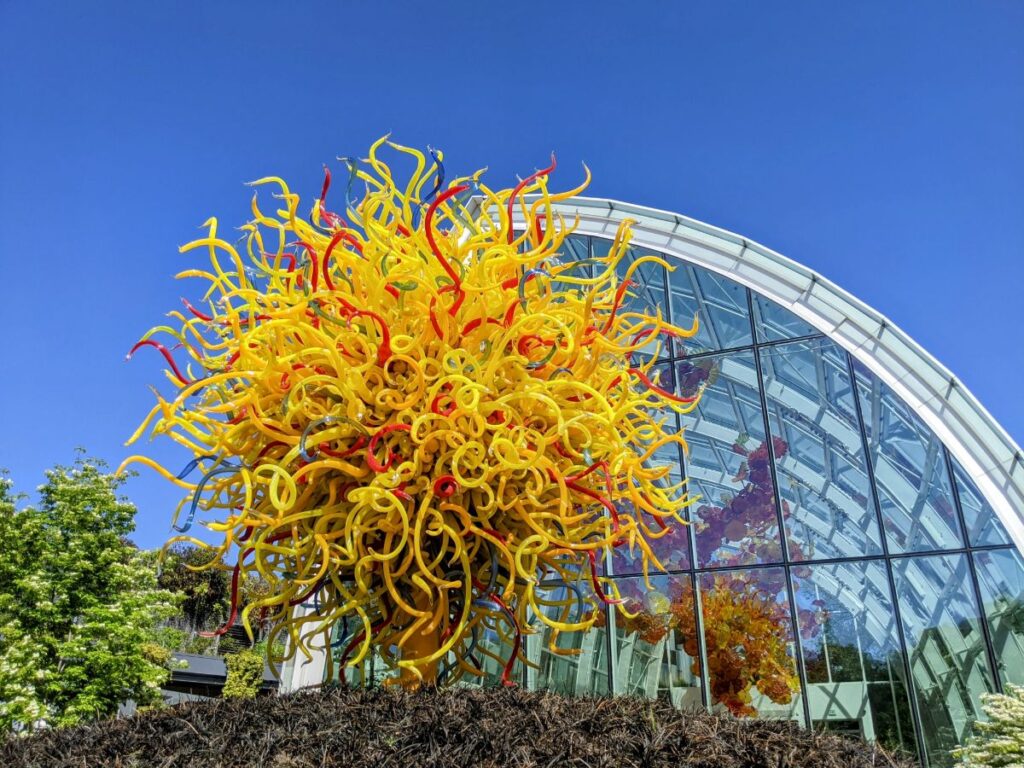
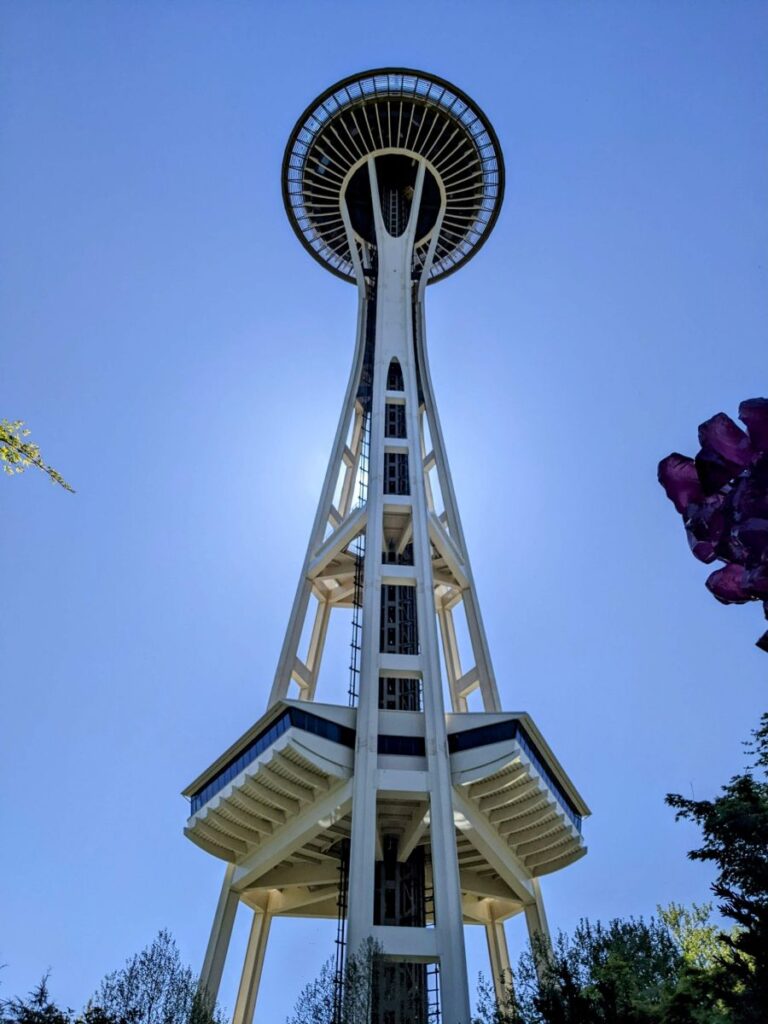
The Art Plaza between the Glasshouse and the main building showcases an open-sided trailer used for glass-blowing demonstrations. There are a few benches and umbrellas but find a seat early if you want to sit for the show – it fills up quickly. Otherwise, there is plenty of space to stand and watch the demonstrations held throughout the afternoon.
If you’ve ever seen a glass-blowing demonstration before, you know what to expect. There’s nothing here you wouldn’t have seen before. But the presenters have a good sense of showmanship and it’s a good, short show, and a chance to sit down if you can snag it.
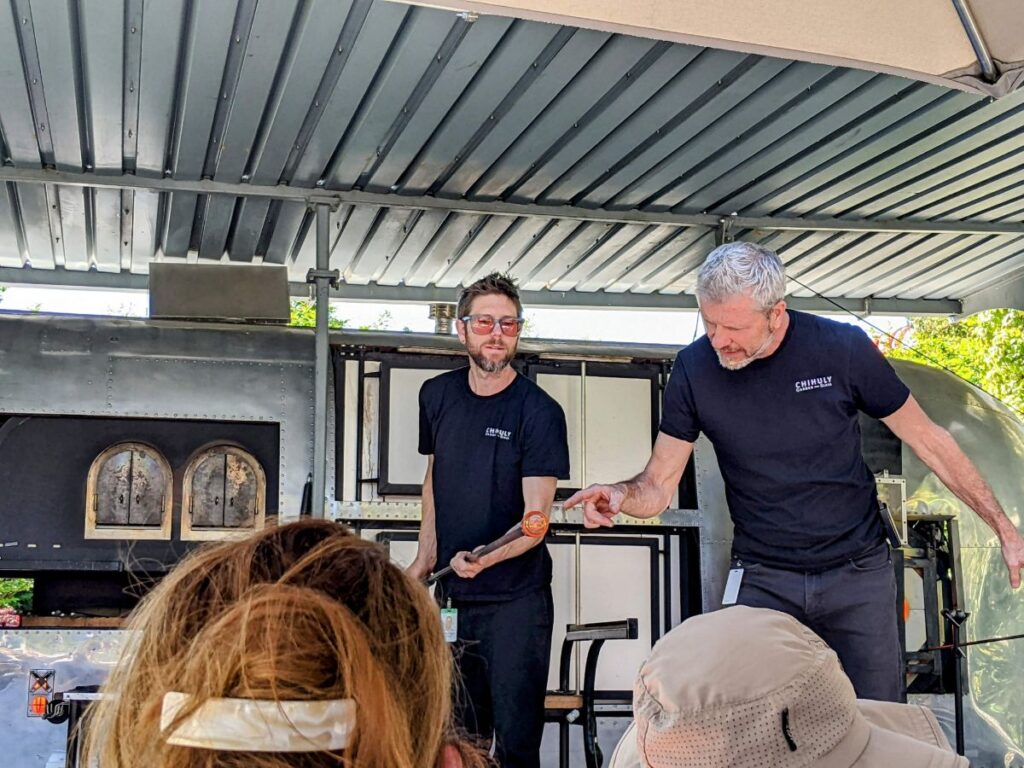
Chandelier Walkway & Theater
Along the outside of the main building is a breezeway with several more chandeliers. These are in the more typical style and smaller than the ones inside. At the end of the breezeway is the entrance back into the building.
At this point, you can either head into a theater or proceed to the gift shop & exit. Inside the theater is another chance to sit down, this time in the air conditioning. A series of short films play about Dale Chihuly and his installations around the world.
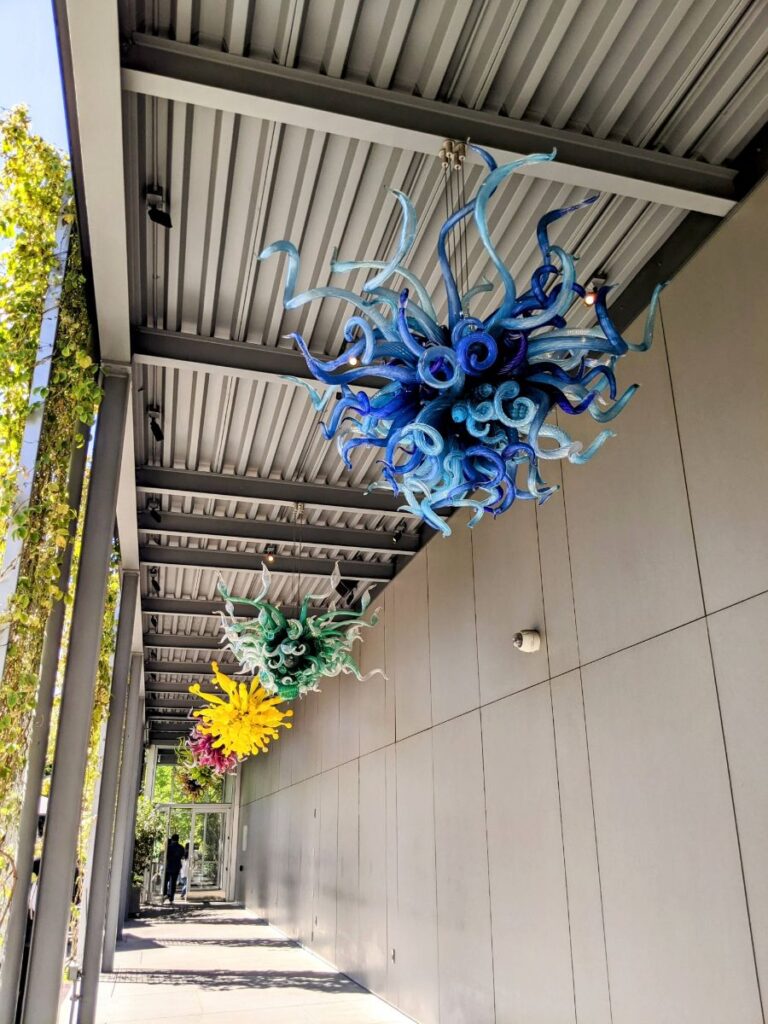
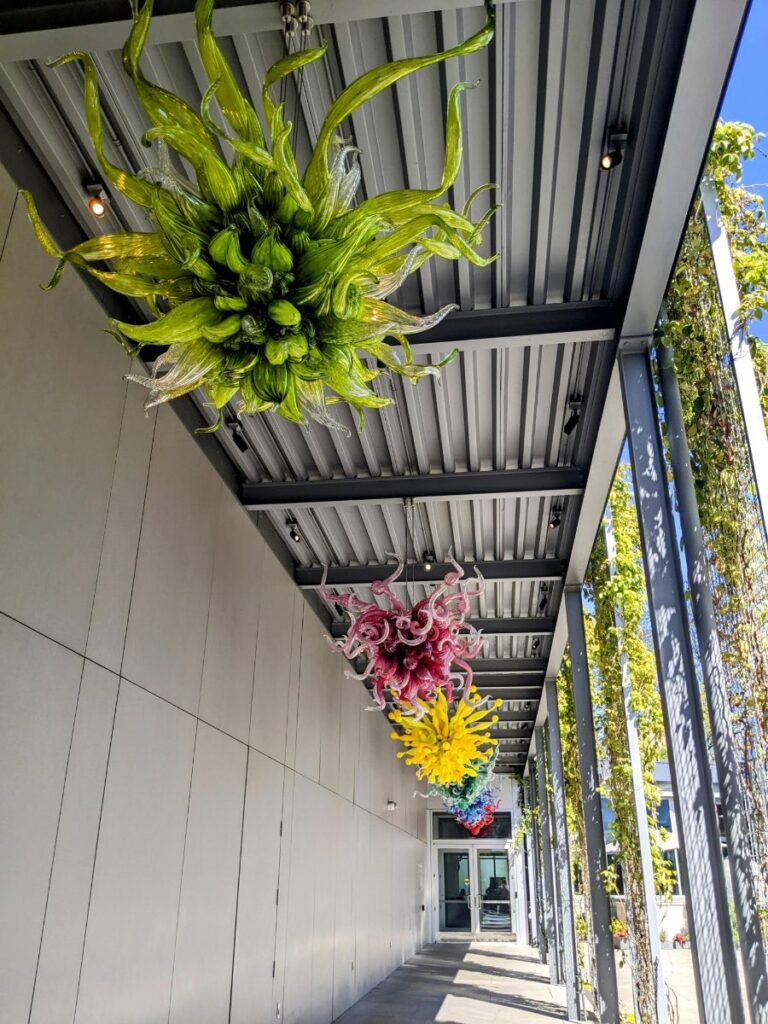
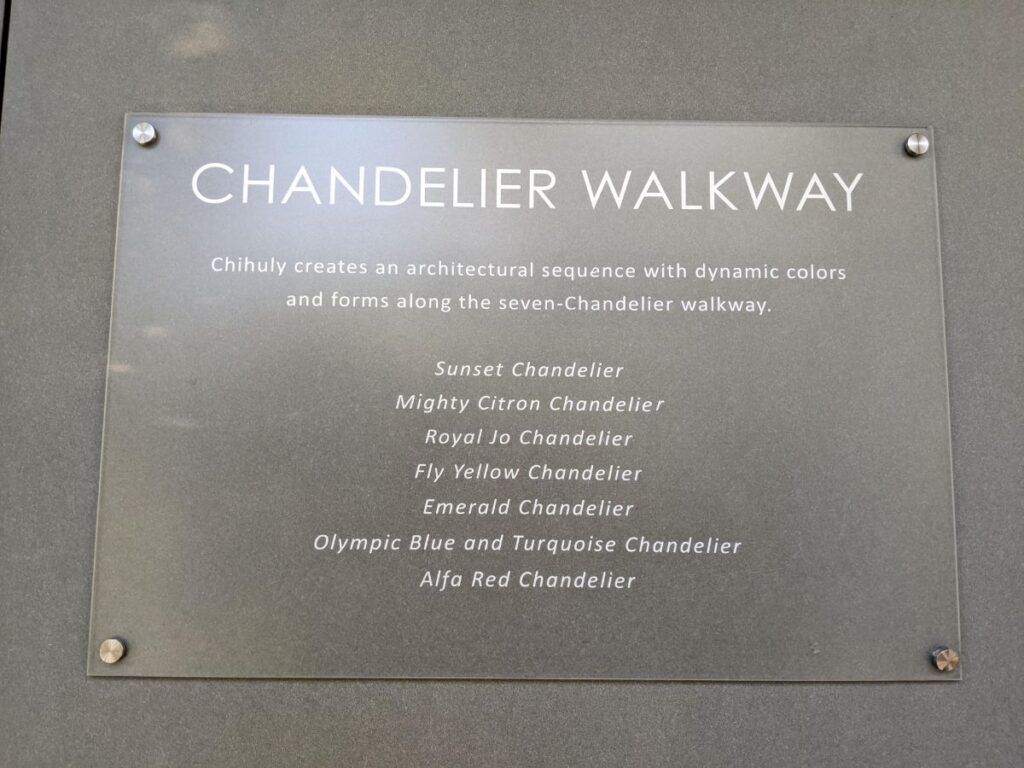

The Bookstore/Gift Shop
When you reach the gift shop at the end of this one-way journey, you’ll find books and art pieces, and souvenirs from soft Chihuly-branded hats to pencils and notebooks. At the back are some Chihuly-like glass pieces you can take home for a few thousand dollars each (and an employee there ready to help you – or make sure you don’t walk off with one.) And I was delighted to find some pottery from Orcas Island Pottery that I had visited a few weeks before.
Oddly, the glass items made during the glass-blowing demonstrations in the Art Plaza aren’t sold in the Chihuly Garden and Glass gift shop. Instead, you can find them next door in the shop at the base of the Space Needle.
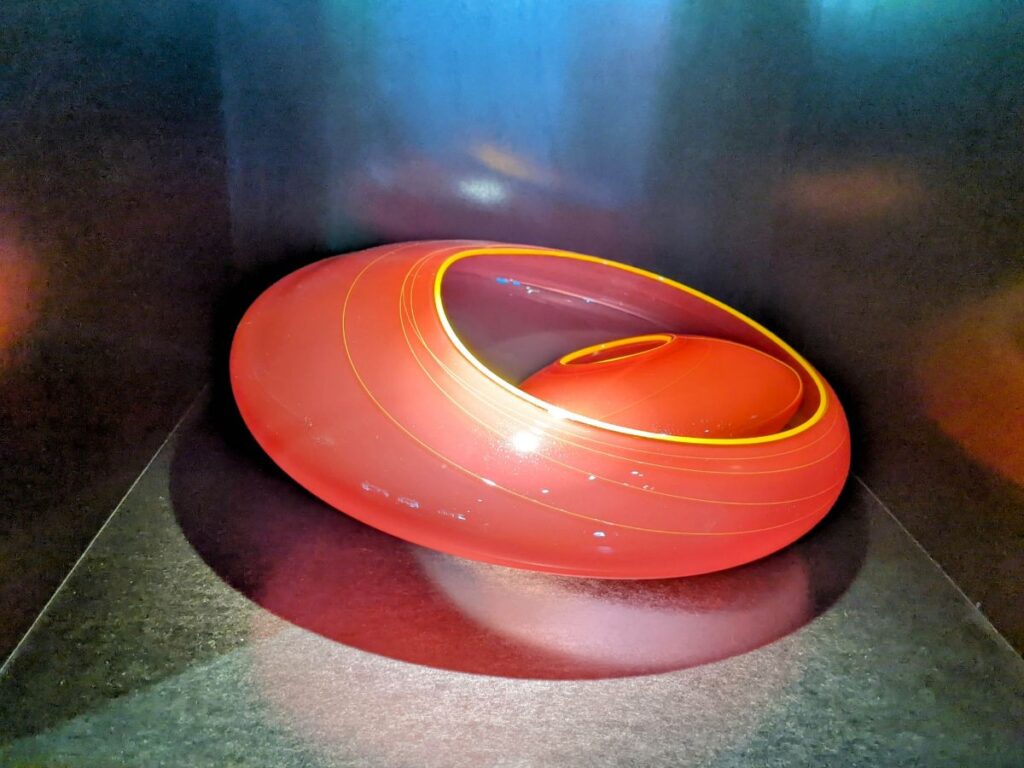
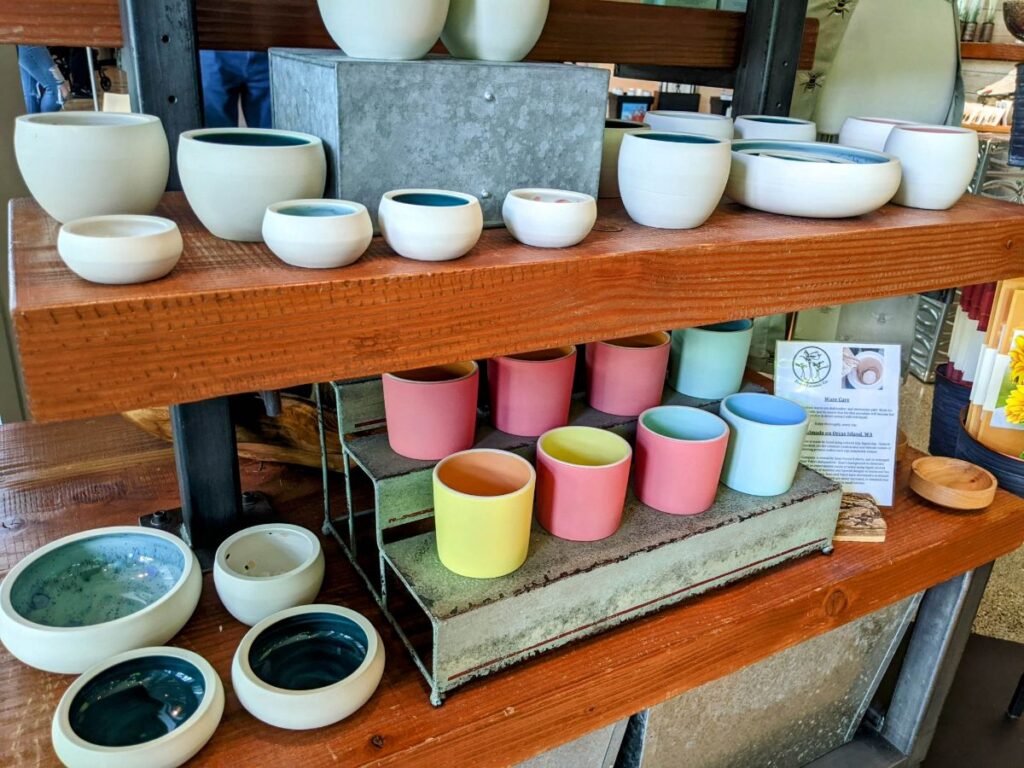
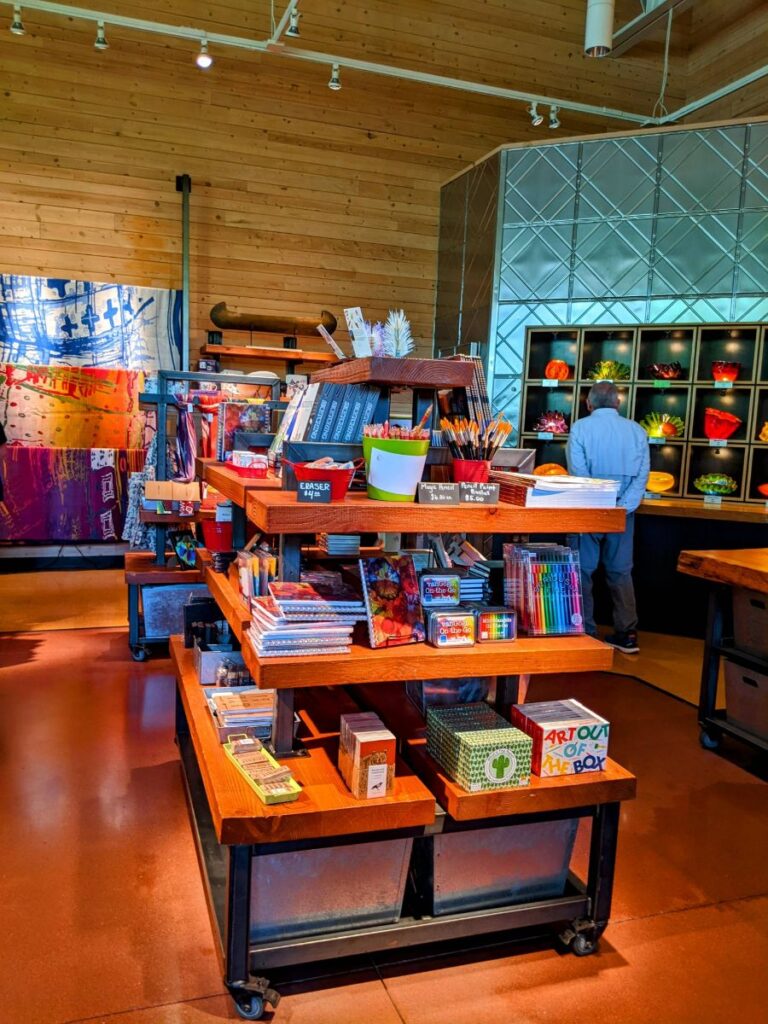
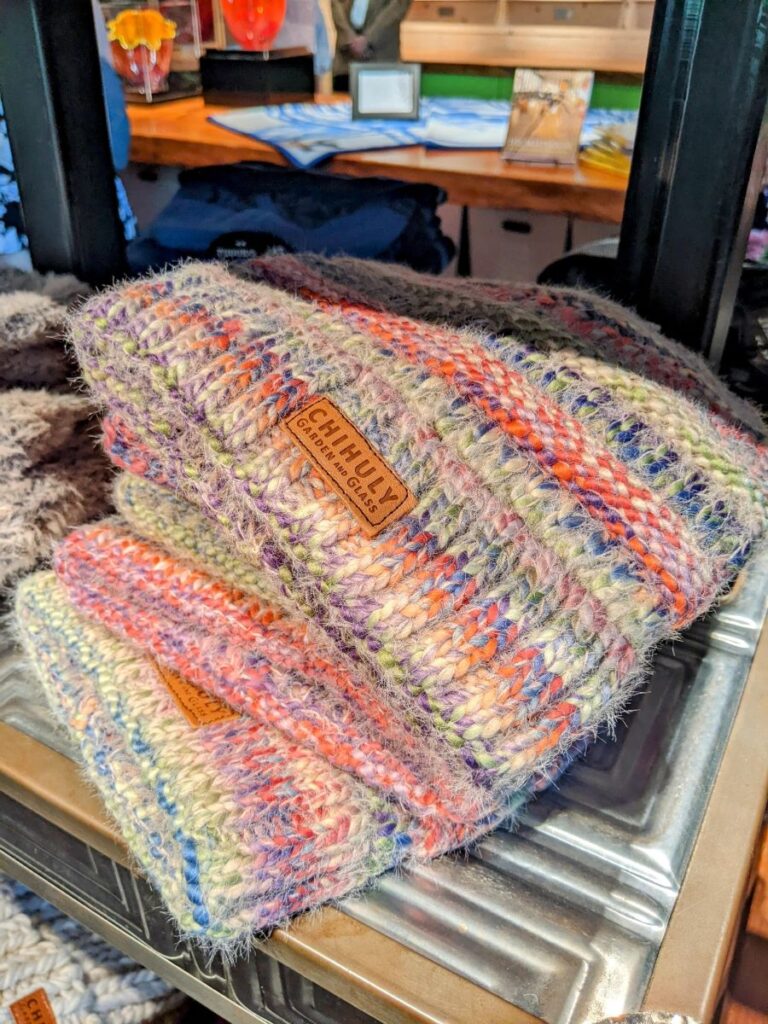
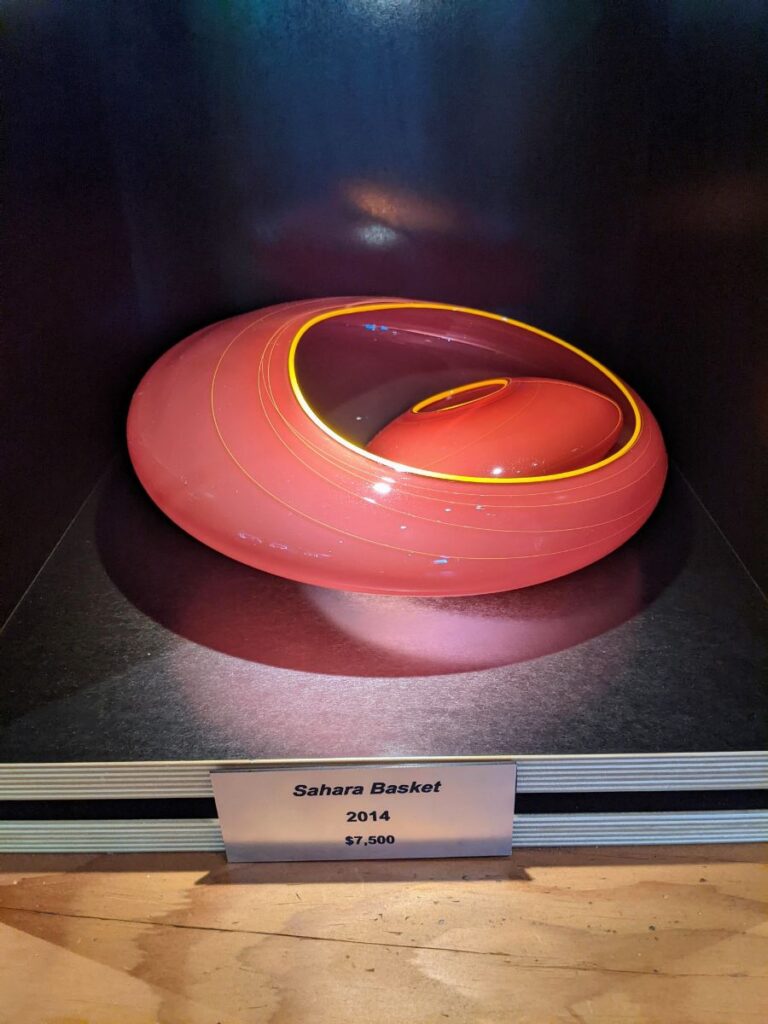
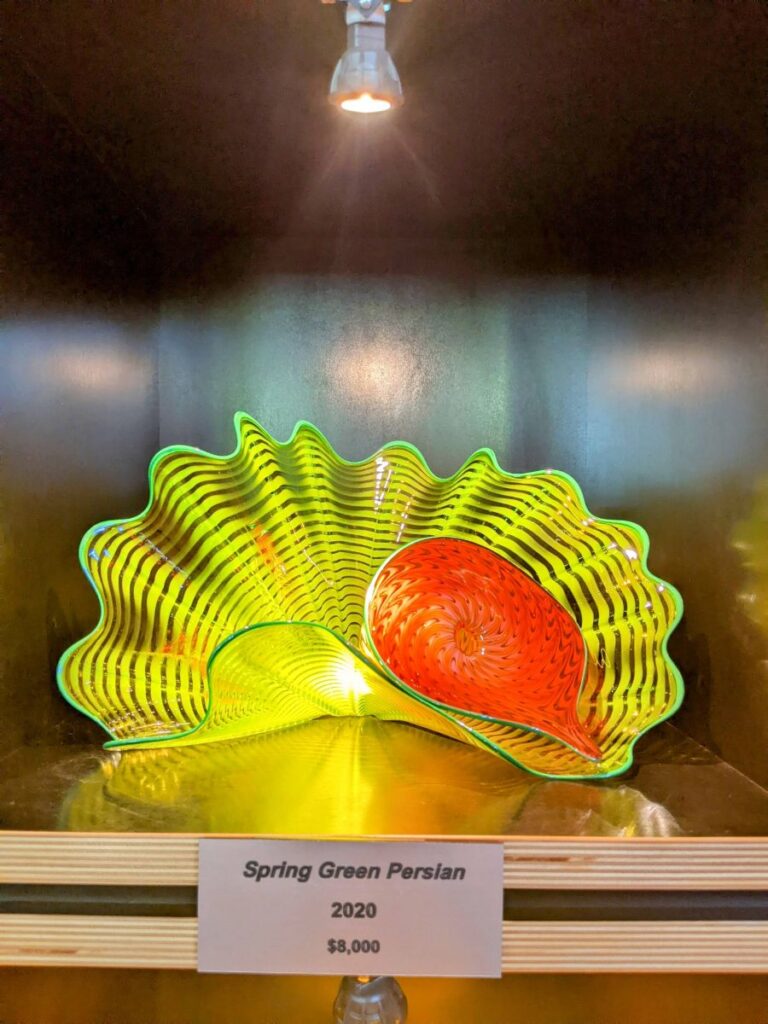
The Bar at Chihuly Garden & Glass
The restaurant and bar attached to Chihuly Garden and Glass is called, unimaginatively, The Bar. But it’s recently been refurbished and has a very imaginative menu and a decor that consists of Dale Chihuly’s personal collections. There are accordions hanging from the ceiling, ceramic figures and old cameras on the walls. Even my table had several antique model cars under the glass top.
Less charming was the execution of my food and the service. I was ignored for a good bit after I sat down, but luckily my food came out quickly once I ordered. I tried a vinegar-based soda that was interesting – all three sips of it. And a house salad cost me the same even when I had the chicken removed (though that’s not unusual.) It was also supposed to come with a vinaigrette but arrived with a creamy dressing that was so spicy that my mouth was tired of it before I was halfway through. None of it is an experience I’d like to repeat.
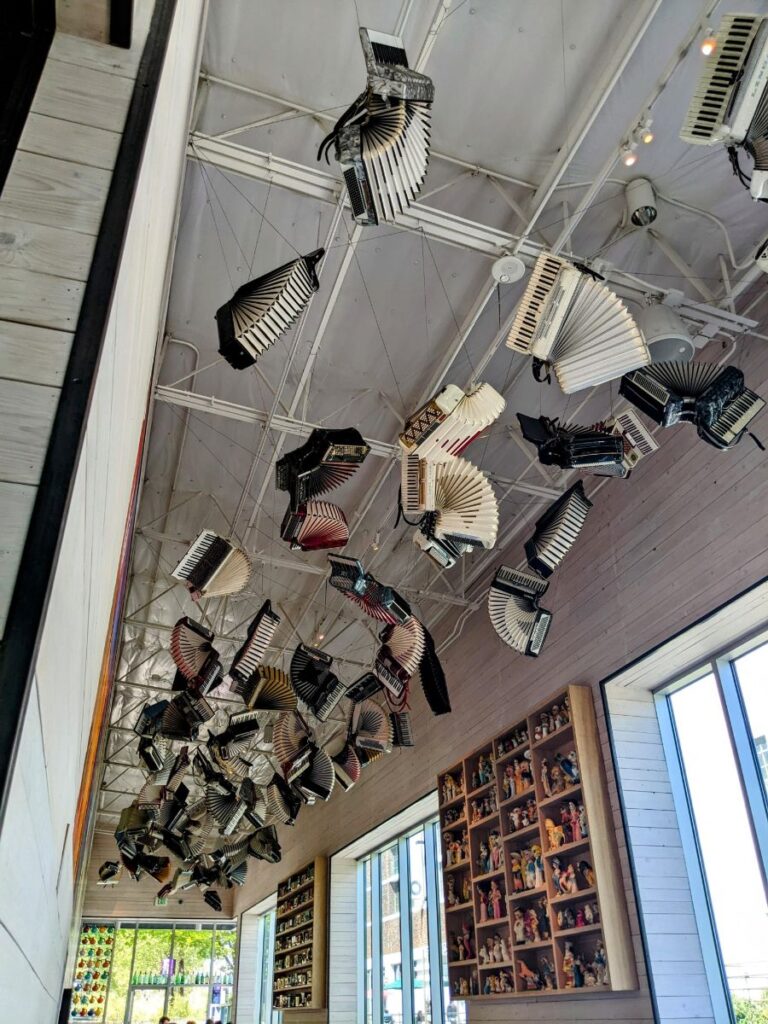
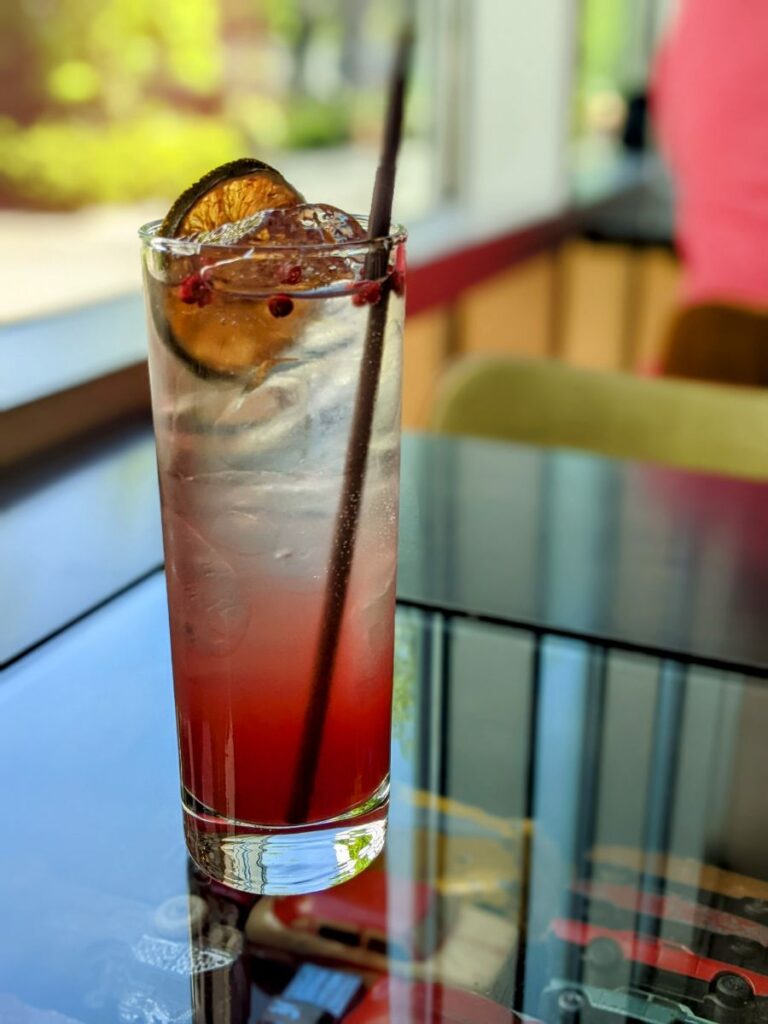
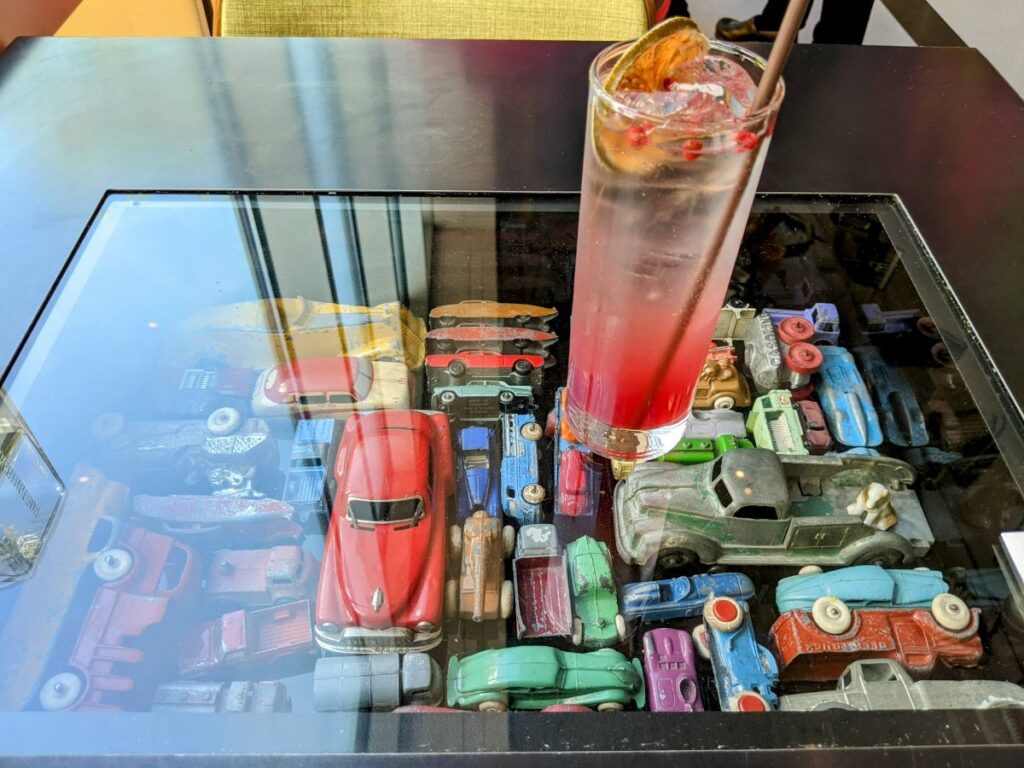
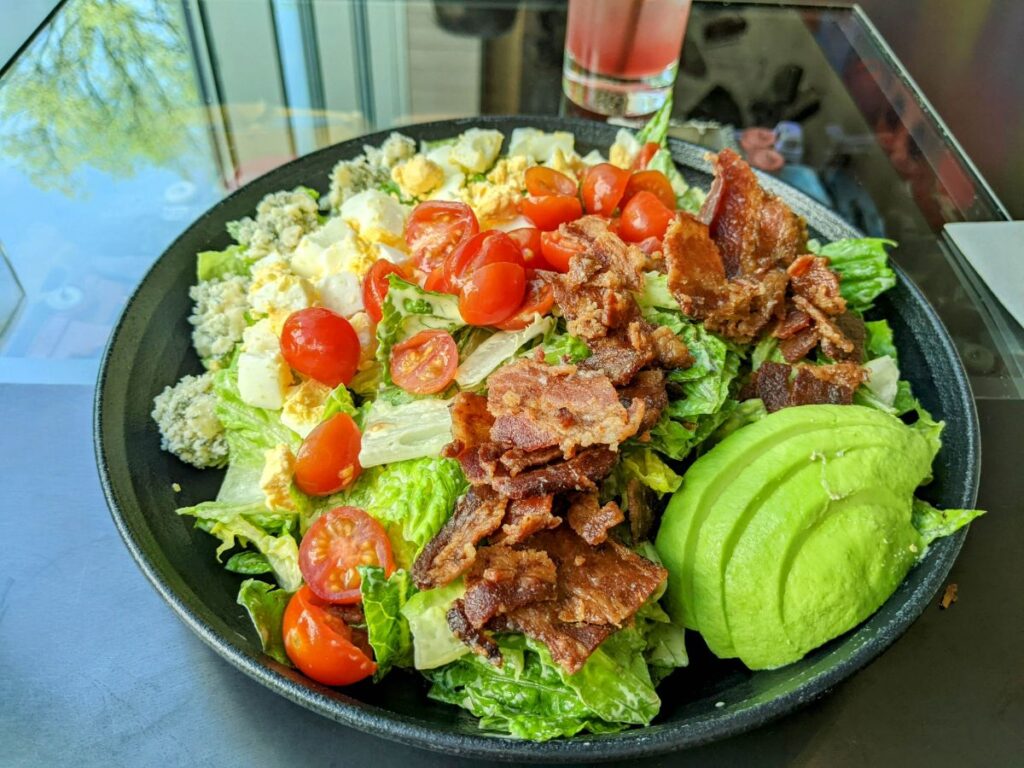
I really only opted for The Bar because I was already pretty hungry, and not sure what my options were at Pike Place Market, my next stop. (Turns out, I would have had more than enough choices.) A better option would have been the nearby Armory building with its food hall inside. But there were also food trucks on my way to Pike Place, so basically, any option would have been better than this one.
Admission
The cost to visit Chihuly Garden and Glass is $35 for adults on a weekday. It’s $2.50 more on weekends, and lower if you come after 6 pm. Seniors 65 and over are in the $25.50-$32 range and youth ages 5-12 are in the $22.50-28 range.
You can also buy as part of the Seattle CityPASS, which is fairly common, and what I did. For $119, you get access to the Space Needle, Chihuly Garden and Glass, the Seattle Aquarium, the Woodland Park Zoo, or a boat cruise.
For a recommendation on where to park – check out my post on the Space Needle.
However you see it, and as commercial as I find Dale Chihuly’s art, Chihuly Garden and Glass is not to be missed as part of your visit to Seattle if you like art even the least little bit. Even if you don’t, it’s pretty cool.
Be First to Comment